#there are some narration boxes that kind of give insight into his thoughts
Text
thinking about the time they actually gave joey dialogue in the new teen titans: games…
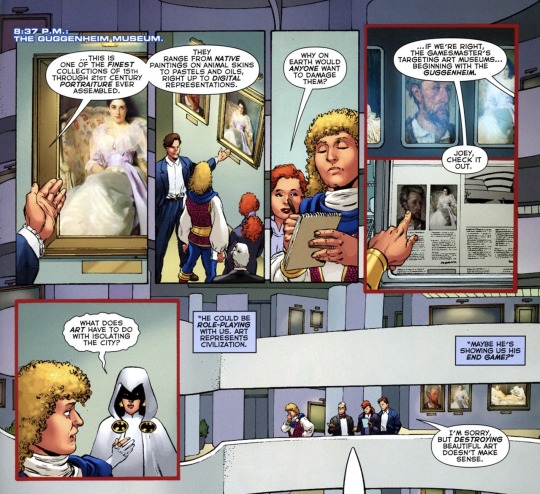
“He could be role-playing with us. Art represents civilization. Maybe he’s showing us his end game?”
this says sooo much about him: his deductive reasoning skills, his appreciation for art, his understanding of other people’s psychology. i need more stories where joey gets to play detective, especially in an art or music history context, and i NEED him to have proper dialogue
#imagining an art heist job with his mom in the searchers inc. comic that exists in my head#let him be thoughtful & have a personality beyond just the sweet helpful guy who’s a good listener#we see some of this skill as a tactician in ntt#(that issue where titans tower gets attacked by the hybrid comes to mind#plus the super inventive ways he uses his powers in general)#but there’s a level of characterization you get from dialogue that he’s almost never given in ntt#there are some narration boxes that kind of give insight into his thoughts#and then there’s that issue in late late ntt that has excerpts from a book he’s writing about the titans#but in general other characters vaguely paraphrase things he signs or we just see their response & what he even said is only implied#really it wouldn’t be hard to give him dialogue like at all they did it here with text boxes that have quotation marks#you could also use angle brackets like they do in american comics when a character’s speaking in a language other than english#just have a little ‘*translated from american sign language’ as an editor’s note & people will know what’s going on#joey wilson#the new teen titans: games#undescribed
56 notes
·
View notes
Text
Clone Wars: Stories of Light and Dark- Book Review

“Clone Wars: Stories of Light and Dark” Is an anthology of stories narrating some of the arcs of the clone wars from the perspective of the characters. It gives more details and depth to some episodes, as well as giving us information that makes us have a different view of the events.
This is not exactly a review, but mostly my reactions to reading the book. I do recommend it, if you loved the clone wars and want another perspective on some of the arcs this will be a good read. That said, this does contain spoilers for the clone wars.
#1 “Sharing the same Face” -Jason Fry (from the episode “Ambush”)
Okay this was once one of the most light-hearted episodes of the series and now I ended up crying. I did not expect an order 66 reference here. Every time Yoda addresses Dooku is painful. Seeing how Yoda perceives the clones is really heart-warming, but knowing how it all turns out in the end is really sad and during the whole text you are really aware of that. In the show you kind of forget about what’s going to happen for a while, but this text just keeps you thinking about it constantly. It was a good read, I loved it. I found it really interesting knowing Yoda approaches the clones the same way he approached his students at the temple, and knowing what his opinions on the clone army it was a good detail. Loved this one.
Did I care that much about this episode before? No. But watching it right after reading this made me cry for half an hour. (I am a really emotional person, so take this with a grain of salt.)
#2 “Dooku Captured”- Lou Anders (From the episodes “Dooku Captured” and “Gungan General”.
This was a funny read, and the fact that the events are narrated by Dooku Himself made it even more hilarious. It’s supposedly a holorecording Dooku was doing for Sidious, and you can tell by his words that he was so done. Poor Dooku deserves a meditation day after it. You can tell how annoyed he was by the whole situation and his perception of Anakin Skywalker and Obi-Wan Kenobi. They really are bothering for the count. I’m surprised he didn’t retire after this event, man’s gotta be really tired. Also, when they were tied together, they just shared a braincell and most of the time, Dooku was the one carrying it. The love he had for Qui-Gon does not extend to rest of the lineage, clearly.
At first it was really slow, but after they get captured by the pirates it just gets funnier. Good story to read after the sadness the previous text gave me.
Also, the fact that Dooku canonically records himself venting to Sidious is hilarious to me. Like, can you imagine being Palpatine and receiving daily vlogs from your apprentice ranting and complaining about Anakin and Obi-Wan? Dude was tired, of course he would let Anakin decapitate him in the end.
#3 “Hostage Crisis”- Preeti Chhibber (from the episode “Hostage Crisis”)
For an Anidala shipper this is a must read, because you will know exactly what Anakin thinks of his wife and how he views Padmé. This text was more Anakin centric (I believe the next one is Padmé centric) and it was a delight. I haven’t read much in canon about stuff that involves Anakin’s feelings so this was really good.
The scene from the beginning of the episode? Is hotter when you read it, trust me. For a clearly SFW text, this was intense. I’m pretty sure I can guess all of Anakin’s kink only by what was implied in his thoughts. Is also really sweet to see how much she cares, but also know why everything went downhill at the end. Good retelling.
#4 “Pursuit of Peace”- Anne Ursu (from the episodes “Heroes on both sides” and “Pursuit of Peace”)
I really love Padmé Amidala. My favorite senator. If you have seen my review of Queen’s Peril you KNOW How much I love her, and even when this text was written by another author, I still got the same feeling about her. Padmé is amazing. This arc is one of my favorite of the Clone wars because it’s the arc that let you see that it wasn’t a black and white kind of situation, both sides were being played. An none of them were really worrying about their people, they were in it for the money. I love reading Padmé’s thoughts on the whole situation. Also, the way this story is written makes what went down with Padmé and Anakin in the third episode make more sense and more in character. She is a strong, good, and smart politician. But she is also motivated to see the light in the dark and preserve the light, it gave me major Qui-Gon from “Master and Apprentice” vibes. It did make me tear up a little, because when I finished it, I realized everything she did was for nothing. She was too kind in a galaxy already so corrupted.
Also, Palpatine stop calling her “my child” you disgusting sith lord, I know you are responsible for her death and so do you, so shut the f up. Padmé was doing everything right and she hasn’t done anything wrong in her life whatsoever.
“Just because there’s darkness in something does not mean you do not love it. You show it love, you show it light, and you hope it chooses the light”.
She was talking about the senate but you just KNOW she isn’t really talking about the senate.
This story re-telling broke me, just as the first one. I am not ready for the next one. Do I have to? Man, I really don’t want to go through Umbara again.
#5 “The Shadow of Umbara” -Yoon Ha Lee (from the episodes "Darkness on Umbara," "The General," "Plan of Dissent," and "Carnage of Krell”)
I was, indeed, not ready for it. It doesn’t really add much to the story… except pain. Rex’s pain, to be precise. Let my man mourn Hardcase :C I just wanted to give him a hug, him and all of the clones to be honest. Fives was as good as always, but re-reading his lines knowing what happens to him made me sad. I hate Pong Krell, get you dirty hands off my babies. I don’t think this re- telling made me sadder, but that’s only because it was just as painful as the episodes.
Dogma my beloved, you deserve everything.
I love how this arc develops Rex character and his attitude towards the war in general.
#6 “Bane’s Story”- Tom Angleberger (from the episodes “Deception”, “Friends and Enemies”, “The Box” and “Crisis on Naboo”.)
Is Cad Bane the Regina George of the Bounty Hunters?
The answer is yes. Yes, he is.
I wasn’t really excited to read about Cad Bane at first, I felt that everything that had to be said about the guy had already been stated in the show. He was just a mean bounty hunter in space. But this was actually pretty funny to read, specially because it’s narrated in first person from Bane’s perspective on what happened with Kenobi. And it’s hilarious.
He is basically re telling the events to Boba and Bossk while he is in jail again. During his story you can learn a few things about him as well, specially what his thoughts are in relation to some important topics. You would think he is only concerned about the money and blasting people, and you would be right. But he also does have an opinion on what’s happening on the galaxy at large, on the jedi, on Palpatine and Dooku. But those opinions don’t affect how he gets the job done. It was really interesting seeing him internally judging Kenobi for being a liar, and knowing something is wrong with the jedi order if they pulled that off. He knows everyone is being deceived, but doesn’t know how. That’s why he doesn’t care, and doesn’t get involved on anything unless you offer to pay him. Money moves him, but not the people who has it.
It was a good story, and I also liked to see how Bane respects Boba and sees him as the one that’s going to take his place eventually.
We know from the deleted episodes that Cad Bane was supposed to be killed by Boba Fett, but we haven’t seen that in canon yet. I really hope they answer what happened to Cad Bane in the current canon, I would love to see that in a comic, or in a book.
#7 “The lost nightsister”- Zoraida Cordova (from the episode “Bounty”)
I love Asajj Ventress for a million reasons and this story just made me love her even more. It’s the same story from the episodes but with an insight of what Ventress is thinking about. Which is unsurprisingly very depressing but the story itself turns out to be pretty uplifting.
It’s about her thoughts on what happened after the massacre of her sisters, her family, and how she deals with everything she had already lost. How lonely and worthless she feels. But during the course of the story, we see her reconnecting with who she is, and learning her value. Learning she is a powerful person, master or not.
It was also really sad to see how she compared herself to others. She was really sad and angry that nobody cared about what happened to her people, no one that cared about her. She saw how people wanted the girl in the box back and thought about how nobody would ever do the same for her and it was sad.
I also find very depressing that she couldn’t mourn her family.
But then she said this:
“What made her so special? What made her worth—No. She couldn’t think that way. This girl’s worth didn’t diminish her own. “
And like, I’m 100% rooting for her here.
Also, I love that once she realized the girl from the box was being smuggled to be essentially a child bride, she didn’t hesitate to scam the old creep. She may be an assassin, but during the course of this story you learn that she is disgusted by men who take advantage of female beings. I also love her internal monologue after the guy was bothering her in the cantina and how she just knows that if she can defend herself, she will do it with no hesitation.
Lovely story, I love knowing more about Ventress. Beautifully written.
#8"Dark Vengeance”-Rebecca Roanhorse (from the episodes "Brothers" and "Revenge")
It’s so on brand for Darth Maul to have his entire story be about Kenobi. It’s narrated by him, but directed towards you, like he is telling the reader a story. That in some stories could be like an awkward thing, but here it was well done. I love Maul and like, I could picture us having that conversation, well, me listening to him monologuing.
I really liked that he started telling the story from the events that happened on Naboo. You get to really see what happened from his perspective and understand why his hatred of Kenobi only grows over time.
Also, Darth Maul was like “I can excuse murder, but I draw the line at being rude”. Which is so morally wrong, but very fitting to his character. He is really upset at Kenobi for not caring about what happened to him. From what I gathered of the info that he let us know, he would probably like it more if Kenobi killed him instead of having to spend all those years in the garbage. Nobody cared for him enough to go and check up on what happened to him. That doesn’t excuse murder though.
The interactions he had with Kenobi let us know that it was not very jedi like the way he treated Maul, ignoring his rage and letting it consume him. Obi-wan just kept adding fuel to the fire because he was also really angry at Maul for the murder of Qui-Gon, not realizing that that would only make Maul be even angrier. And we know how that ended up for Satine Kenobi.
Final thoughts: Savage, I love you.
#9 "Almost a Jedi"-Sarah Beth Durst (from the episode "A Necessary Bond")
I thought this story was going to be from Ahsoka’s point of view. It was not.
I’m not mad at it though.
The story itself does focus on Ahsoka but it’s narrated by Katooni. It’s basically about how much she adores Ahsoka and wants to be like her, but also doubts herself a lot. She thinks she is not good enough to be a jedi. But her experiences both with Ahsoka and with Hondo Ohnaka makes her change her mind.
I want to say that I love the fact that it’s canon that she drew a poster of Ahsoka for her room because she really admired her that much it's so wholesome. It’s cute, and also let us see the perception the younglings had of Ahsoka.
Also, the bond between Hondo and Katooni is really wholesome. This also made me realize that this encounter with a young jedi is the reason he is immediately friendly with Ezra in Rebels. Ezra and Katooni do share similar personality traits sometimes.
Deep diving in Wookiepedia after reading this I found out that Hondo’s ship in Galaxy’s Edge is called “The Katooni” and now I’m sad thinking he was probably devastated when he learnt about Order 66 and what Vader did to the younglings. Great now I’m angsty about a chaotic evil space pirate.
I think it was confirmed by Dave Filoni that those kids are dead now. May the force be with them, they were good enough jedis.
#10 "Kenobi's Shadow"-Greg van Eekhout (from the episode "The Lawless”)
This is the re-telling of one of the saddest clone wars episodes. The episode just lets you think that everything’s going to be alright, that they are going to survive together, lets you hope that they take off just in time… and then it doesn’t happen. I’m still not over Satine’s death. And this made it even sadder. There were so many points their story could’ve gone differently, but their story was already at an end.
This is in third person but heavily focusing on Kenobi’s thoughts along the way. He really was close to turn to the dark side, but his love for Satine and his grief made him not surrender to it. But he felt an anger, a justified one, but an anger that I have never seen in a jedi other than Anakin Skywalker. And we all know what happens to him.
It was a good but sad reading. I won’t be reading this one again. It’s too much. I knew what was going to happen and it still hit me hard. I wish things would’ve gone differently for the both of them. I wonder if we will get flashbacks to this in the Kenobi show.
Also, I really need an Obi-Wan Kenobi and Satine book of their time on the run.
#11 "Bug"-E. Anne Convery (inspired by the episode "Massacre”)
I can’t talk openly about this story because it’s not actually featured on the clone wars. It’s a really good story, specially if you want to expand on the lore regarding Dathomir and the Nightsister in the new canon. It’s perfectly executed, and even when the story isn’t about any of the main characters it hooked me from start to finish. Definitely one of my favorite stories of the book and If I had to pick one story from this anthology to read again it would be this one.
It has more gruesome details than the others and the atmosphere is dark, and I loved it. I would read a whole Dathomirian Nightsister novel written by this author if it was in this exact same style. I really liked it a lot.
In summary, I really enjoyed reading this Anthology. I would really recommend it to anyone who is fond of the Clone Wars or the prequels era. Adults, Kids, Teens, Young adults. I think I would’ve enjoyed this book as a kid as well, and I enjoyed it a lot now in my early twenties. It contains a little bit of everything and that makes it a really complete anthology.
#star wars books#book review#clone wars#the clone wars#star wars#hondo ohnaka#ahsoka tano#swtcw#assajj ventress#darth maul#ventress#feral opress#dooku#kenobi#anakin skywalker#prequel trilogy#tcw#yoda#clone wars stories of light and dark#star wars novels
25 notes
·
View notes
Note
What exactly is 'character voice'? Is it merely a character having opinions on things? And how do I have good voice if I am writing in first or third person omnipresent? Do I give the narrator's opinion on things? The character's opinions? The different opinions of the characters?
Voice is a tricky thing to pin down -- a bit of a “know it when you see it” type thing. But I’ll see if I can break it down a bit.
First: Stories will contain both “authorial voice” and “character voice.” Authorial voice is the individual writing style of the author, and you’ll start to notice it most strongly after you’ve read multiple works by one author. Character voice on the other hand is unique to the character. A strong character voice will often overshadow the author’s voice, which is usually a good thing! It keeps every book you read from an author from sounding the same. If you’re reading a book in first person or close third POV, the narrative should be in the character’s voice. If you’re reading it in a more omniscient POV, the narrative might have a very different voice. Books that alternate POVs might have different voices for different perspectives, so that you could tell who’s speaking even if the chapters weren’t labeled.
But OK. What makes up Voice in writing?
Opinions. Characters with a strong voice have opinions about the world, and those opinions color the way they see things. They don’t sit and tell you how they feel, but instead deliver the world through the lens of those opinions.
Focus. What a character chooses to pay attention to vs ignore in the world around them. This gives an underlying glimpse at what is important to them.
Word Choice. On a structural level, voice comes down to word choice, grammar, syntax, etc. being used with purpose to create a cumulative effect.
Books without a strong voice sound dry, like a technical manual or book report. They lack any poetic devices or colorful insights. A strong voice is one that doesn’t sound generic, which means it’s not usually “correct” from, say, a middle school English class perspective. (In fact, some young writers may often butt heads with teachers over the use of voice in writing -- I know I did. Once you get good at it,
It might just be easier to show this in action than try to explain it so...
Carrie, by Stephen King:
She had tried to fit. She had defied Momma in a hundred little ways had tried to erase the redplague circle that had been drawn around her from the first day she had left the controlled environment of the small house on Carlin Street and had walked up to the Barker Street Grammar School with her Bible under her arm. She could still remember that day, the stares, and the sudden, awful silence when she had gotten down on her knees before lunch in the school cafeteria -- the laughter had begun on that day and had echoed up through the years.
Carrie calls her mother “Momma” even in her head, which already implies a lot about her socioeconomic class, upbringing, and intelligence. She didn’t try to fit in, she tried to ‘fit’ -- a non-idiomatic description. The run-on second sentence gives a hint of a racing thought. “Redplague” as one word is evocative and more powerful than a more drawn-out metaphor might be.
The Hitchhiker’s Guide to the Galaxy, by Douglas Adams
Mr. L. Prosser was, as they say, only human. In other words he was a carbon-based bipedal life form descended from an ape. More specifically he was forty, fat and shabby, and worked for the local council. Curiously enough, though he didn’t know it, he was also a direct male-line descendant of Genghis Khan, though intervening generations and racial mixing had so juggled his genes that he had no discernible Mongoloid characteristics, and the only vestiges left in Mr. L. Prosser of his mighty ancestry were a pronounced stoutness about the tum and predilection for little fur hats.
Comedy lives or dies on the strength of its voice, and Douglas Adams is a master at a very specific type of comedy. Here we see it on display. Prosser is an antagonist, and he’s here being described in a way that suggests, without stating outright, that he’s quite pathetic. We open with a cliche saying, and then immediately deconstruct it in a way that’s overly precise -- a technique of absurdism. Then we compare him to Genghis Khan (also a villain, and a very strong one) in a side-by-side parallel that definitely paints Prosser unflatteringly (his genes are “juggled,” a word that evokes clownishness) and the “little fur hats” detail is the icing on the cake -- imagine standing beside Genghis Khan and the ONLY thing you have in common is the hat! (”Predilection” is also a fussy-sounding word. “Stoutness about the tum” sounds like a childishly euphemistic protest, sort of like “big-boned” but dialed up to 11).
The Cabin at the End of the World, by Paul Tremblay
Wen’s eighth birthday is in six days. Her dads not so secretly wonder (she has overheard them discussing this) if the day is her actual date of birth or one assigned to her by the orphanage in China’s Hubei Province. For her age she is in the fifty-sixth percentile for height and forty-second for weight, or at least she was when she went to the pediatrician six months ago. She made Dr. Meyer explain the context of those numbers in detail. As pleased as she was to be above the fifty-line for height, she was angry to be below it for weight. Wen is as direct and determined as she is athletic and wiry, often besting her dads in battles of wills and in scripted wrestling matches on their bed. her eyes are a deep, dark brown, with thin caterpillar eyebrows that wiggle on their own. Along the right edge of her philtrum is the hint of a scar that is only visible in a certain light and if you know to look for it (so she is told). The thin white slash is the remaining evidence of a cleft lip repaired with multiple surgeries between the ages of two and four. She remembers the first and final trips to the hospital, but not the ones in between. That those middle visits and procedures have been somehow lost bothers her. Wen is friendly, outgoing, and as goofy as any other child her age, but isn’t easy with her reconstructed smiles. Her smiles have to be earned.
The thing I love about Tremblay’s writing style is how wonderfully understated it is. At first blush, it seems very straightforward and precise. But the details work to give such a rich image beyond what’s on the page -- like one of those paintings that creates a cat with just like, two brushstrokes of ink. This paragraph is jam-packed with information -- the character’s age, race, adoption, gay parents -- but also illustrates her character indirectly: a kid who is interested in precise numbers, competitive in a specific way, self-conscious, skeptical. Little lines really stand out, like “caterpillar eyebrows” and “reconstructed smiles.”
Horrorstor, by Grady Hendrix
It was dawn, and the zombies were stumbling through the parking lot, streaming toward the massive beige box at the far end. Later they’d be resurrected by megadoses of Starbucks, but for now they were the barely living dead. Their causes of death differed: hangovers, nightmares, strung out from epic online gaming sessions, circadian rhythms broken by late-night TV, children who couldn’t stop crying, neighbors partying til 4 a.m., broken hearts, unpaid bills, roads not taken, sick dogs, deployed daughters, ailing parents, midnight ice cream binges.
But every morning, five days a week (seven during the holidays), they dragged themselves here, to the one thing in their lives that never changed, the one thing that they could count on come rain, or shine, or dead pets, or divorce: work.
This is the opening of the book, and it does a perfect job of setting the tone for the story -- a combination of humor and horror, a lighthearted touch on a really dismal subject. Like the Douglas Adams example, it relies on an excess of hyper-specific detail to create comedy through absurdism. Describing the store they wrok at as a “massive beige box” says a lot -- beige is a boring color, box is a boring shape (and implies constraint, the opposite of “think outside the box” etc.) Calling the workers “zombies” and using zombie words (”stumbling”, “streaming”) invokes a specific set of concepts -- mindlessness, for starters, and death -- and using that to describe going to a job certainly implies something about what it’s like to go to work, right? This paragraph could just come outright and say “work is soul-sucking and pointless and takes you away from things that are important” but it illustrates that instead. A perfect example of “show don’t tell” in action.
Hopefully that gives a bit more illustration to what I’m talking about. As you read, pay attention to the way things are said and how that varies from one book to the next, and you’ll get a better intuition for voice (and learn to craft your own through practice).
Some general tips/things to think about when creating strong voice for your narrative and characters:
Education and socioeconomic level of the characters. A professor will talk differently from a car mechanic; a college graduate sounds different from an elementary school student; an inner-city black teen will use words differently from a New England socialite. Think about what kind of background a character has and choose vocabulary and syntax that makes sense for them.
Evocative descriptions. Words come with baggage, and good writing puts that baggage to use to create a meaning stronger than what’s on the page. Precision with language, not just what words mean but what they imply, is the hallmark of good writing.
Words used uniquely -- in other words, avoiding cliches and descriptions we’ve seen before in favor of creating new word combinations that do the heavy lifting of the previous bullet point.
Hopefully that helps!
#writing advice#writing tips#narrative voice#strong voice#asks#ask box is always open btw#sometimes it takes me a bit#but I love answering writing questions#especially grammar type things#that is my jam#nuts and bolts of writing baby#my precious
162 notes
·
View notes
Text
My honest, humble, and not-objective-at-all opinion about THE CLONE WARS : STORIES OF LIGHT AND DARK
THE CLONE WARS : STORIES OF LIGHT AND DARK by various authors, published in 2020 (canon)
To be really honest, this book wasn't supposed to be the next on my « to-do » list. I'm currently reading Lords of the Sith and enjoying it, and was willing to make my next review about it, but the last two weeks has been a rough time and I couldn't manage to read a single page.
So instead of making you wait longer, I'll use the Clone Wars book as a filler, because I think I can be quick on this one (I think ? Let's see how many pages I'm going to write then).
In case you're not aware, Stories and Light and Dark (let's just call it SLD) is a short stories collection about the Clone Wars, each different story being about a set of Clone Wars episodes you already know about, but from a different point of view, focusing on one character being the narrator.
If you haven't seen the Clone Wars TV show yet, this book will probably be very confusing most of the time, because clearly what's at stakes isn't the story itself but what's going on in the head of a certain character. You'll probably end up thinking « yea that was cool I learnt about what was thinking Kenobi at this point but I haven't had any idea what was going on. »
Since every story is independant and was written by a different author, I can't give you a summary of the whole book. I'll give my opinion on the book at the end of the ticket but I'll take a bit of time to say what I thought about each story first.
Get your seatbelt on because we're going to start the SLD rollercoaster now :)
SHARING THE SAME FACE by Jason Fey
Not bad but no overly interesting. The whole point is to tell us how Yoda feel about the Clones, but to be honest we don't learn really much more in the story than in the episode.
I liked how Yoda compare the Clones to children and how different from each others he make them feel, reassuring them that they are all different and they all matter for him. That was nice.
Not much more to say about it.
DOOKU CAPTURED by Lou Anders
Probably the most goofy story of the book, based of some of the goofiest episodes on the show. It's telling us from Dooku's point of view the story of how he was captured by Hondo Ohnaka and had to team up with Obi-Wan and Anakin to escape.
It was really funny to read but also really awkward (faithful to the show...), and in my head I was constantly thinking « there's no way he's going to tell all of this stuff to his master without being slowy burned by his own shame ». At the end of the story, when Dooku changes his mind and decides to delete his holorecording and never tells his master about this whole story, I was like « yas boy I would have done the same, just keep it to yourself ».
That's the kind of story that put a smile on your face but leaves you with a bit of « wtf did i just read »
HOSTAGE CRISIS by Preeti Chhibber
This story suffers from what will a major problem in others stories : telling us something we already know without sounding redundant. It's the whole «Cade Bane and his crew taking the Senate hostage » but from Anakin's pow, and... the show was already mostly on Anakin.
It wasn't bad, not gonna lie, I liked reading how Anakin was feeling about Padmé, their relationship and her job. But it was only the first pages of the story. Once the hostage-taking has begun, it's just about describing us Anakin trying to save the day (and I've seen the show, I know how it goes) and not much about how Anakin feels. Yet it could have been interesting, Anakin being under the urge of saving his wife, the stress and the anger against Bane... but I didn't feel any of that. Just a Jedi doing Jedi stuff and being the hero at the end of the day.
To me, this story is a missed opportunity to show us how the Dark Side of the Force is strong in this one.
PURSUIT OF PEACE by Anna Ursu
Before reading this story I wasn't sure about how I felt about this whole book. This was the first one allowing me to make my mind and to think I was glad I bought it.
Unpopular opinion (depending on how you feel, of course) : I'm not a fan of Padmé. I liked her in The Phantom Menace, because she's a young, fierce, and powerful girl trying to make her way as the queen of Naboo. In Attack of the Clones and Revenge of the Sith, I feel like she has been switched from « young powerful woman » to « Anakin's love interest in need of being saved ». I know that's not completely true and I know she can still make her way with a lasergun, but like a lot of female characters in stories, once she is completing her role as a love-interest, there's not much left for her except waiting for her husband at home and making children.
That being said, that's not her fault if her character was poorly written in the AotC and RotS. I feel like The Clone Wars is trying to correct it and make her a stronger character, even leading some episodes of the show.
And because this review is already longer that the other ones, I'll try to make the rest of it short : I can say I loved this story. It's about Padmé meeting her separatist friend Mina Bonteri with Ahsoka, and how she tries to stop the war.
We see how strong and determined she is, how aware she is of the mask she has to wear in public as a senator, how far she's ready to go to stop the slaughter. How hard it is to be a female senator wanting peace.
I liked that, like the matching episodes, this story isn't all black and white with bad separatists and good republicans. I liked having a glimpse at Star Wars politic too (not-so-unpopular opinion : I'm not a fan of politics either).
Over all the rest, I loved that this story made me appreciate Padmé more that before.
Big thumb up.
THE SHADOW OF UMBARA by Yoon Ha Lee
As you could guess, this is the Umbara quadrilogy episodes, and it's from Rex's pow. And my biggest disappointment of the book. I loved The Umbara quadrilogy, even though I feel like it could have been a trilogy instead because sometimes it's a bit repetitive, but I loved it.
This story is nothing more that the description of the TV show. I'd love to say « no more no less » but it won't be true, since in the show we can see the sacrifice of Hardcase. The only bit you'll get is « Rex wanted to mourn Hardcase properly, but there was no time. » That's all, case closed, move along.
Oh, and when Clones realise they were shooting each others and were fooled by Krell ? « Rex clenched his hand as Waxer took his last breath. » Not a SINGLE word about how he FEELS.
The episodes was more effective in showing us Rex's dilemma with facial expressions than this story is with words.
So this story would be better called « No more than the Umbara quadrilogy, only less ».
It made me really angry because so more could have been said. I still wonder how this story passed the quality test to make it to the final book.
BANE'S STORY by Tom Angleberger
Or, as I like to call it, « Bane's story, by Bane, with Bane as the hero »
This was sooo fun and good to read. Bane is one of my favorite Clone Wars characters and I really felt like Bane was the one telling me the story. A breath of fresh air after the Umbara failure.
It's about these episodes when Obi-Wan disguise himself as Hardeen, a bounty hunter, to foil Dooku's plan to capture Palpatine, but all from Bane's pow. And he's so sassy about it.
I could hear Bane talking directly to me, with his words and his personality. Some of my favorite sentences of the book are in this story.
When they get chased by Anakin and Ahsoka and he tells us « I always heard Jedi were supposed to be in control of their feelings, but the two crazies on our tail sure weren't in control. » and « She had two lightsabers and was swinging them around to much I thought she was going to cut off her own horns. »
Or when he met Dooku : « I hope he wasn't expecting me to kneel like Eval. That's one thing I won't do. Another is call some old man my lord just because he's got a long beard and a big house. »
And a last one that made me laugh so hard, when they're about to abduct Palpatine during his speech on Naboo : « If you ask me, listening to that old bag of wrinkles run his mount ain't no festival. If we could kidnap him before he started, the Naboolians or whatever they're called would probably give us a medal ».
That's what I wanted from this book. Episodes I already knew about but told from a new perspective. And it was such a pleasure.
THE LOST NIGHTSISTER by Zoraida Córdova
Another bet won for SLD. It's about Ventress joining the Boba crew to earn some money, by protecting a certain box on a certain train (you know what I'm talking about if you saw the Clone Wars).
Maybe not as insightful as Bane's Story (definitively not as fun, but clearly it wasn't the point), but really intersting too. It takes us into Ventress's mind after the Dathomir massacre and the despair is palpable. And while the show leaves us uncertain about why Ventress is saving Pluma, the story is very clear about it and gives us some introspection about Ventress, her sisters, her family.
It could have been a little further, but still it was really good to read. I honestly don't have much to say about it, not my favorite but I genuinely liked it.
DARK VENGEANCE by Rebecca Roanhorse
or The true story of Darth Maul and his revenge against the Jedi known as Obi-Wan Kenobi
(just to be clear, this subtitle isn't by me, it really is in the book :D )
I hated to admit it, but it was a liiiitle bit of a disappointment too, but that's just because I expected so much from it (in case that's not clear by now, Maul is my absolute favorite and I got his face tattooed on my leg okay?).
I'll focused first of what I loved from that story. Maul talking directly to the reader, as if he was talking to a child. That gives a strong feeling of power from him, good characterisation. He apologizes when his description are too bloody, justifies his slaughter of innocents, really talking like he was relating what was going on in his mind, sometimes interrupting or correcting himself. That was good. Like Bane's story, I felt like the character was adressing to me directly.
So, why the mitigated opinion, why the disappointment, you'll ask ? Maybe because the story was uneven. Sometimes I really was into Maul's mind, but sometimes it was just plain descriptions of the episodes I already saw. I may be hard on this one. I liked Maul's reactions to Kenobi teasing, how he want to crush him and make him swallow back his words.
I liked the fact that Maul sincerely, deeply, thinks the Jedi are liars and hypocrites.
I didn't really like the fact that sometimes Maul was sounding just like he was complaining. Like, you know, in Clone Wars, when someone is like « Hey Maul, how are you today ? » and he's like « MY PATH HAS BEEN SO DARK ».
… well, after all I guess it's faithful to the show :o
Don't believe everything I wrote before. This story was good, it's about Maul. Go read it.
ALMOST A JEDI by Sarah Beth Durst
About how a bunch of kids and Ahsoka escape pirates, then Grievous.
Another usually unpopular opinion : I don't like kids in stories or TV shows (nor in real life). I always feel like kids are supposed to be the comic relieves, or the cute factor, making you say « aaaw look how adorable and naive and dumb that little kid is » and I'm always rolling my eyes and thinking « get your shit together kiddo, that's an adult story and you're ruining it ». (I might be a little excessive on this one, I'm not always doing it).
In the quadrilogy about the young apprentices and Ahsoka, most of the kids were going on my nerves, and I'm glad I didn't felt this way about Alsmot a Jedi. I'm so glad Katooni was chosen to be the narrative instead of Petro.
Overall it was a good story. Katooni's insecurities were touching, her admiration for Ahsoka was too. Like in this passage, « I wanted to scream. But I didn't, because Ahsoka wasn't screaming ». She's so afraid, so petrified to be unworthy. I really cared for her. And her relationship with Hondo is great too. (And Hondo is great, what did you expect?)
That was cool and refreshing to read.
KENOBI'S SHADOW by Greg Van Eekhout
This. This is my favorite story from the whole book. It was so dark, so growling with sadness and anger and pain.
I don't think I can describe how it was to read it. That is how I wanted to feel. I wanted to know how Obi-Wan felt when Maul murdered Satine before his eyes. Now I know and I want to hide in a hole and not mess with that Jedi, ever.
Obi-Wan is usually used as a fun character in Clone Wars, with his deadpan sens of humour. It was heartbreaking to see him in the Mandalorian episodes, and reading it... well it was heartbreaking but frightening too.
An absolut must-read. Believe me. I was shocked.
BUG by E. Anne Convery
Bug is a original story, not an adaptation of a Clone Wars episode, thus it can't be treated like the other stories.
Real real quick plot summary ? Bug is about a little girl called, well... Bug, living with her parents, running an inn on a planetoid, near an abandoned military relay tower. One day a witch from Dathomir comes to the inn and wants to use the tower in hope of finding tracks of her disappeared daughter.
It was good.
Ok that's the end of that review, thanks for reading and nah I'm kidding.
Why was Bug good ? First of all, because it was the only original story of the book. And even though some of them were really really good, it didn't bring the curiosity of discovering something new. You lack suspens and surprises. Bug brings them back. I wanted to learn so much more about this young girl and the witch ! And Falta's story was hypnotizing. Litteraly. Hooray for learning more about Dathomir, about their culture, their history and the relation between the witches's clans. (Not hooray for learning that loving for the sake of love and not power is unthinkable for Talzin. I wouldn't have wanted her as a mother if you see what I mean.)
I hope so much that we'll see more of Bug and Falta in the future. This was too interesting to be left apart as a one-short story.
So, if I had to FINALLY resume my opinion on The Clone Wars : Stories of Light and Dark ?
PRO :
- getting involved inside the mind of characters in situations I already knew about
- some really fun, dark and/or insightful stories
CON :
- an overall mixed feeling about the books because some stories are not up to the rest.
- you'll have to get through some passages that are just formal descriptions of what happened in the TV show
TO CONCLUDE :
This took way more time than I expected and I should definitively not have called that review « a filler ».
As I aleady said, SLD is an rollercoaster. You'll get stunned and you'll get disappointed, and go through all the emotions between.
Was the book worth the money ? Well, the hardcover is pretty and some illustrations are cool, but the quality is irregular.
If you're short on time or money, I'll suggest you find a way to read only the stories that are really interesting you, based on any review you'll find on the internet.
Cheers to everyone reading me, thanks so much for all the notes, follow and reblog. It means a lot. Take care of you and your relatives during these hard times.
Tagging @maulpunk <3
2 notes
·
View notes
Text
The Key to Understanding Deltarune: The Halloween Hack
So we’re currently in the middle of a 4000 year content hiatus
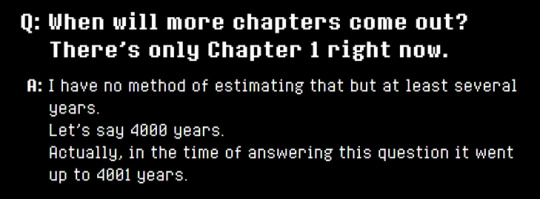
Which is unfortunate, because ever since the big iconic Halloween-day surprise demo drop, my brain has been rattling a baseball bat against the inside of my skull and chanting “CONTENT, CONTENT, CONTENT”
Undertale was like candy for the thematic analysis side of my brain. I still wake up in a cold sweat some nights going “fun value......he put a quantitative value on fun.....numbers going up.....”
I am desperate to know what kind of themes Deltarune is going to tackle. Can you effectively predict that from one (1) 3 hour demo? No. Does my brain care? No.
Which is what lead me to the wonderful world of intertextuality, or examining how a media text is shaped by other media texts
It started out with a kiss, how did it end up like this with me doing a playthrough of EarthBound, the video game that Toby has cited as his biggest inspiration for Undertale
That was fun & interesting (the “throwing away an emotionally engaging experience to grimly make Numbers Go Up” thing feels a lot closer to home after trying and failing to get the sword of kings), but it didn’t provide much insight into Deltarune, specifically. It wasn’t enough. I needed more. I was willing to dig into literally any intertext (except Homestuck, which no force on this earth can compel me to read :) )
anyway thats how I ended up playing Toby Fox’s high school fangame
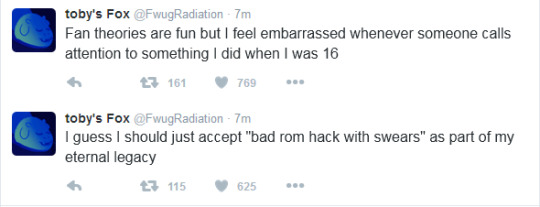
And somehow (sorry Toby) I walked out of there with an unironic theory (a game theory....if you will....): Deltarune is Toby’s adult reexamination of the Halloween Hack.
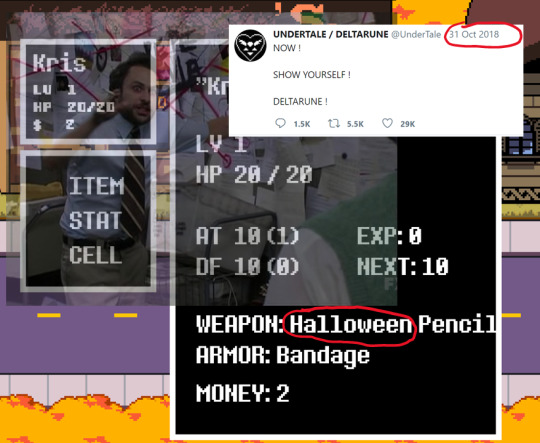
What is the Halloween Hack?
You know that thing where, like, people take the engine of a Pokemon game and edit it so there’s a new region and a bunch of new fakemon, and also There’s Swears Now
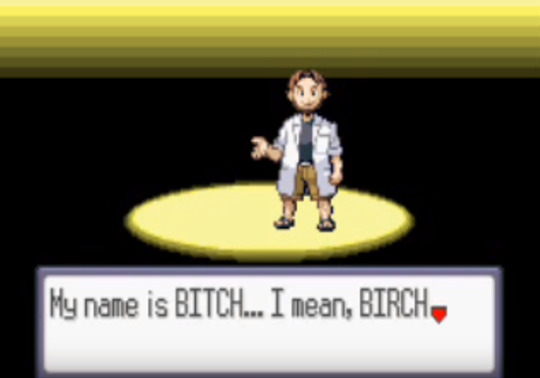
In 2008, Toby Fox entered a contest on an EarthBound fansite for the best Halloween-themed EarthBound hack
In one sense, reducing the Halloween Hack to a “bad romhack with swears” is a little bit of a disservice. There are some glimmers in there of a really affecting, thought-provoking game, and you can see some of the early blueprints of what would later become Undertale (“do video game ‘monsters’ really deserve to die” is a major theme, and the character of Dr. Andonuts was effectively split up into Alpyhs, Asgore, and Sans)
But it’s also. very much a fangame made by a 16-year-old.

You can read a basic summary of the Hack here. High school-age Toby wrote two pretty extensive analyses of his thought process behind the game. I’ll be referring back to them a lot, and I’d highly suggest giving them a read--Toby’s been so famously resistant to making any Word of God statements about Undertale that it’s kind of fascinating to see him being so candid
an extremely long and rambling examination of How This All Relates To Deltarune
The Halloween Hack opens in the town of Halloween Twoson. Twoson is one of the cites in EarthBound, and here it’s been painted orange. and there’s pumpkins now
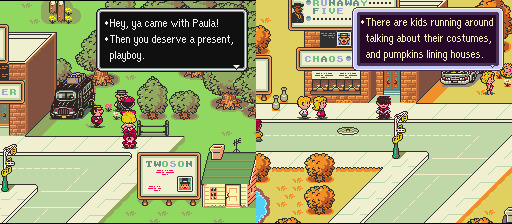
See, high school Toby had...a bit of a chip on his shoulder. In the Making Of notes, he explains that he was frustrated that “most people generally thought I was just ‘another funny guy’”. So he designed the opening of the game to seem unoriginally close to the original EarthBound--like “a regular, funny, lazy hack”--to lull players into a false sense of security before the horror elements set in.
Two interesting things there:
“Lazily, unoriginally close to the source game” sounds an awful lot like the Dark World segment of Deltarune
Halloween Twoson looks very visually similar to Hometown
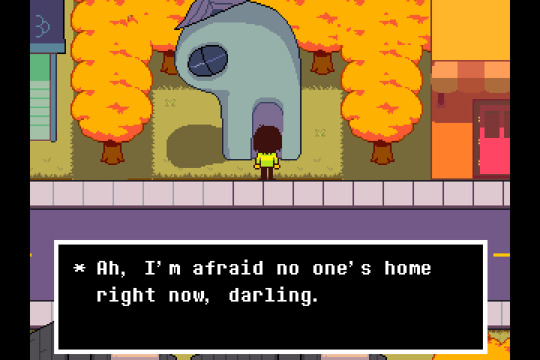
Toby’s description of Twoson also sounds pretty Hometown-esque:
The main impressions of Twoson that I wanted to give the player were: It's funny. It's a nice fall day outside. The person hacking this game is ridiculously lazy. It's a nice place to live. If you look at it a little closely, it's kind of claustrophobic.
And when does the horror kick in? When the player descends into the underground tunnels beneath the city.
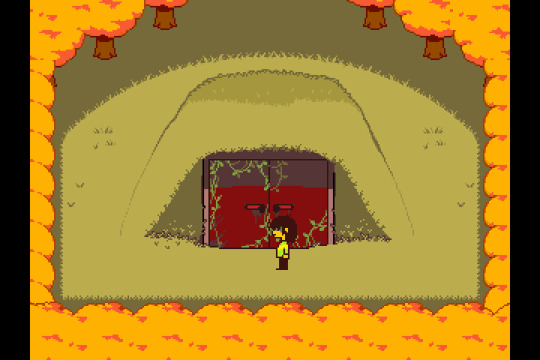
The “horror” in the Halloween Hack is, however, Pretty Not Good.
There’s a whole lot of the flavor text narrator (put a pin in that one) insisting “this is so scary. you’re so scared. your hands shake and your head throbs because you’re so scared.” There’s also a thing where the battle text keeps going “the shambling zombie BITES your HEAD OFF!!! (you lose 15 hp).”
I think the True Lab sequence in Undertale is a decent demonstration that Toby’s come a long way since then (and that Honey We’ve Got A Storm Coming :’) ). But you know what the Hack’s style of horror reminds me of?

My first thought when I beat the demo and saw this stinger was “this looks like an intentionally shitty creepypasta.” Now I wonder if it’s lowkey adult Toby poking a little fun at teenage Toby
The Halloween Hack is a game about railroading. It’s Spec Ops The Line before there was Spec Ops The Line.
According to Toby:
The main theme of this game is the lack of choice. There is really no choice in this game. From the moment you start to the moment you finish, you're destined to kill Dr. Andonuts. There are two endings, but they both eventually end up the same way. It's all a big joke on the player.
You know why there isn't a choice there?
Because you already chose to make Varik go into the door. You already chose to go forward. The only real choice, as Varik realizes at the end of the game, is to stop or keep going. By "stop" he means "turn off the game," and that's all you can do. Anything you play is your own fault for playing, and that's the only real choice you can make.
Interesting? Yeah. A little obnoxious? Also yeah.
That’s one of the criticisms people had of Spec Ops. "The atrocities we commit when we feel like we don’t have a choice” is an intriguing theme, but “~the only way to win is not to play~ [the game I worked hard on for the express purpose of people playing it]” isn’t a very satisfying conclusion.
Undertale, in direct contrast to the Hack, is all about choice. It earns the right to guilt you for the No Mercy Run by giving you every opportunity not to go through with it.
But even Undertale plays a little with the concept of railroading--you can’t stay with Toriel; you can’t spare Asgore in any of the neutral runs; you can’t save Asriel.
Now Deltarune seems to be returning full-on to the Hack’s “your choices don’t matter” premise. But it’s going to need to find something more insightful and satisfying to say about it.
Which makes me really curious about this:

If the Hack has a secondary theme besides railroading/lack of choice, it’s The Soul-Crushing Impact Of Internalized Homophobia.
The tragic antagonist, Dr. Andonuts, destroys his own life trying to repress his gay desire. He retreats into a dream world made of his neuroses and trauma, and he’s inevitably Otherized and murdered by the player. He’s something of a dark version of Alphys, who “disappears” into her lab without ever meeting and getting support from Frisk, Papyrus, and Undyne.
Undertale takes an opposite approach to its lgbt themes--the Underground is a utopia where homophobia and transphobia don’t exist. Everyone respects Frisk’s and Chara’s pronouns. Alphys finds solace and healing in her relationship with Undyne.
It’s a heartwarming growth from the despair in the Halloween Hack. And it’s a vision that’s been deeply meaningful to a lot of people. But that doesn’t mean that there’s no value in exploring issues of homophobia. 16-year-old Toby tried to do that, but...wasn’t exactly at a point where he was equipped to handle it with a ton of sensitivity and nuance.
(There’s. There’s a boss battle where you fight the physical manifestation of Andonuts’ gay repression. It’s a crotch. You fight a crotch.)
Some of the hints in the Deltarune demo, however--the Toriel Has Become Catholic thing; the fact that Alphys and Undyne haven’t met and Mettaton hasn’t been able to transition; the potential trans implications of choosing a name only to have it discarded for an assigned one (“you can’t choose who you are in this world”)--make me suspect that’s one of the themes that Toby will try to revisit from an adult perspective.
The Hack is interested in the idea of the flavor text narrator as a distinct, intelligent entity, whose thoughts and goals don’t always align with those of the player character or the player.
The Hack’s narrator makes a habit of dictating “your” emotions to you (you’re scared; you can sense ‘the monster’ and you want to kill it; etc). The narration starts to seem more and more unreliable, until, as Toby put it, “The narrator starts talking to you personally...rambling about incoherent things.”


At the game’s turning point, you’re given a yes/no choice to kill Dr. Andonuts. Choose yes, and the narrator (mockingly?) calls you a good person, describes the murder you commit, and then narrates what appears to be your (or their? or Varik’s?) psychological breakdown. Choose no, and the narrator tells you that’s not a real choice and redirects you back to the yes/no box. If you press the b-button to try and opt out of the choice (the game’s unofficial subtitle is “Press the B-Button Stupid,” and doing so allows you to follow Andonuts into his dream world), the narrator starts to panic, although the game ultimately ends the same way.
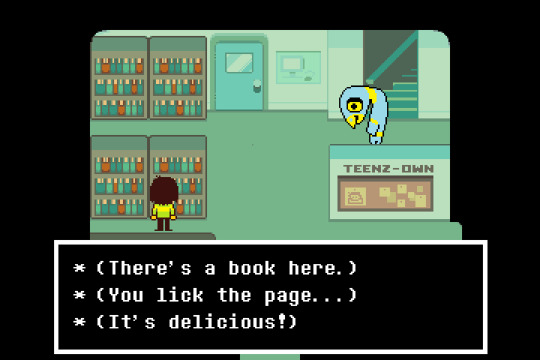
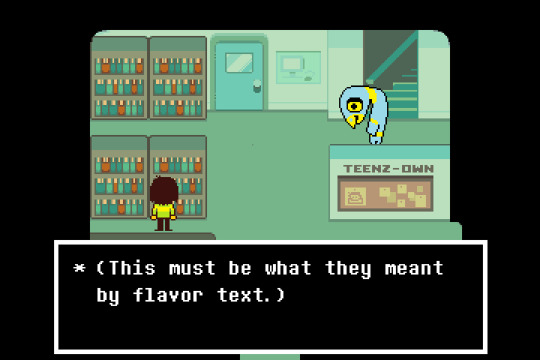
Not to NarraChara Real, but NarraChara Real
The Hack is also interested in the idea of the player character as a possibly-unwilling puppet controlled by the player (who in turn is controlled by the railroading/their need to beat the game).
According to Toby:
As you approach someone you've never met that you're labeling as a monster, your body pushes you forward to kill him. What's funny is that it's not even uncontrolled, it's really just the force of the player's controller pushing that little bounty hunter into murdering Andonuts. You might not realize it, but Varik is almost dead, and yet he can't stop moving because you keep pushing those buttons.
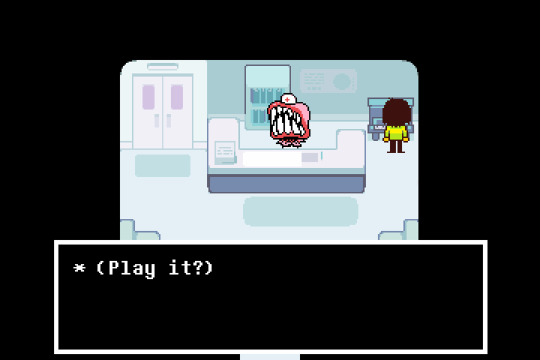
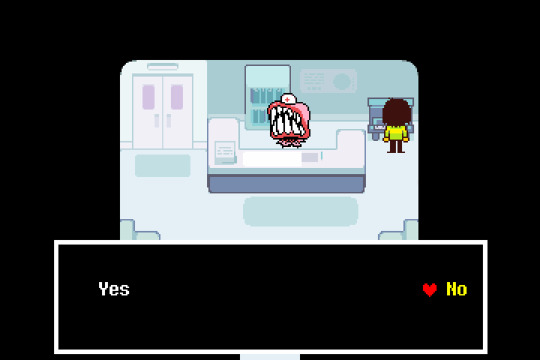
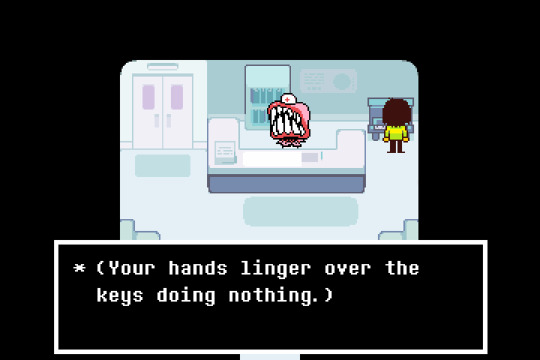
The Halloween Hack is, fundamentally, a nostalgic meditation on an existing game.
It’s a little obvious to say, but the Hack isn’t a standalone game. It’s a hack of EarthBound.
Toby writes:
EarthBound dominated my childhood, shaped my preteen years, and played a large role in molding me into the offbeat pseudohippie I am today. It gave me a sense of humor. It helped me learn how to read. Its lessons served as a basis for my sense of justice and courage.
But at age 16, Toby’s feeling about the game that had shaped him were a little mixed. He describes “the staleness of a fifteen-year-old video game” as one of his motivations for making the Hack.
In Deltarune, he (kind of hilariously) has Alphys parrot his teen-self’s “staleness” line:
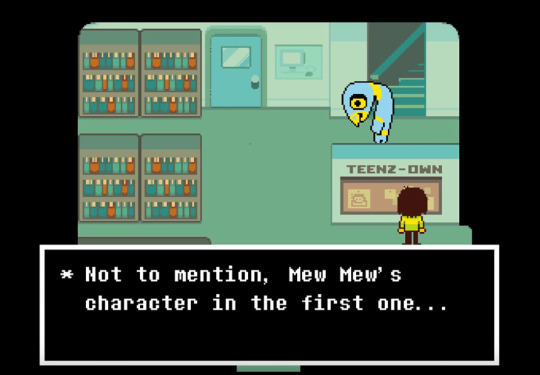
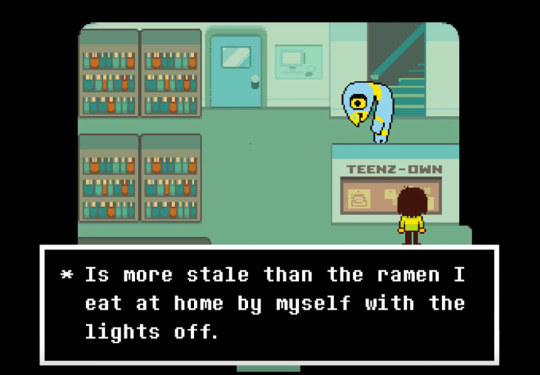
(I could write a whole meta just on the Mew Mew Kissy Cutie vs Mew Mew Kissy Cutie 2 thing)
Still, Toby’s nostalgia for EarthBound is essential to how the Hack operates. Earlier, I said there were glimmers of an thoughtful, affecting game buried in the “bad romhack with swears.” The most genuinely moving moment in the Hack, in my opinion, is the Onett sequence.
You wander though a faded, dream world version of Onett--the hometown from EarthBound--while a slowed down arrangement of the Onett music plays. Snatches of forgotten conversations appear on road signs. Various monsters from EarthBound follow slowly behind you, but don’t attack. The only battles are against creatures called “Remember Me?”
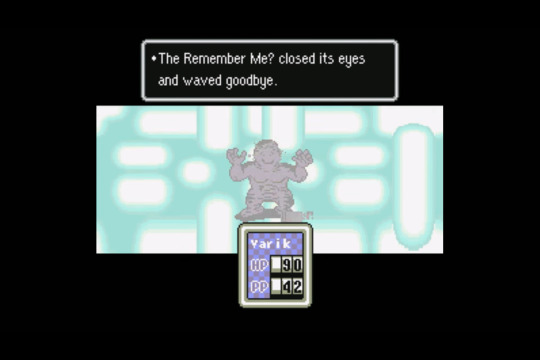
The EarthBound characters appear to recognize “Varik” as Ness, EarthBound’s protagonist--or are they recognizing you, the player, as the same person who played EarthBound once upon a time?
The one problem, of course, is that not everyone has played EarthBound. It’s a relatively niche game. The sense of remembrance and regret and loss in the Onett sequence is universal, but being shaped as a person by the specific video game EarthBound isn’t a universal experience.
But in the years since the Hack, Toby has created something with a wider reach than EarthBound. Something that can evoke that sense of memory and nostalgia in players. A familiar game that he can take apart, rearrange, and examine in an entirely different light.
He made Undertale.
And now he’s rearranging the pieces into Deltarune.

#deltarune#undertale#o and to clarify: i don't think the flavor text thing means that chara's evil#in fact i think deltarune's going to deconstruct that very reading of undertale#which is maybe a whole nother (hopefully much shorter) meta
194 notes
·
View notes
Text
Jon / Sansa Reread - Bran I, AGOT
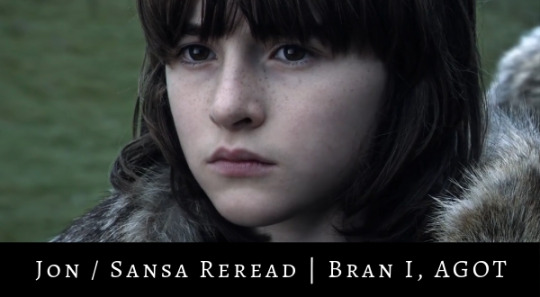
In which Bran sees an execution, talks to Jon, talks to Ned, and then finds some direwolves.
I always love when other people do rereads, so I’m trying my hand at it, with a focus on Jon and Sansa and how Martin writes them. This is essentially fanfic research, and for that it’s always best to go back to the original source.
So if this is a Jon and Sansa reread why am I starting with a Bran chapter? Because while on the surface Bran I is about Bran, it’s also equally about introducing the male side of the Starks and so has a lot of valuable insight into Jon’s character. It’s also one of my favorite chapters in the series for just how sparse and laconic Martin’s style is throughout.
The morning had dawned clear and cold, with a crispness that hinted at the end of summer. They set forth at daybreak to see a man beheaded, twenty in all, and Bran rode among them, nervous with excitement. This was the first time he had been deemed old enough to go with his lord father and his brothers to see the king’s justice done. It was the ninth year of summer, and the seventh of Bran’s life.
This is such a great hook to open a chapter and the book as a whole with and ticks a lot of important boxes in just a paragraph: the setting, Bran’s age and state of mind, and a good hook. Who is being beheaded? Why is he being beheaded? Why is a child going to go see it? As a writer you almost always want to have an underlying tension or question that the reader wants answered to drive them forwards.
Bran’s bastard brother Jon Snow moved closer. “Keep the pony well in hand,” he whispered. “And don’t look away. Father will know if you do.”
It’s interesting Martin has Jon play the role of older brother here rather than Robb. Despite his half-brother bastard status Jon is clearly close with Bran, as we’ll see later when he visits Bran’s bedside after he falls. He doesn’t coddle Bran though; partly this is to emphasize the Stark coldness, but also I think it’s an insight into Jon’s character.
There’s a recurring thread through these early chapters that Jon doesn’t have quite the same leeway as the true born Starks in Winterfell. He’s probably especially sensitive to disappointing Ned. After all, his existence at all is already an embarrassment and spot on Ned’s honor.
Bran’s father sat solemnly on his horse, long brown hair stirring in the wind. His closely trimmed beard was shot with white, making him look older than his thirty-five years. He had a grim cast to his grey eyes this day, and he seemed not at all the man who would sit before the fire in the evening and talk softly of the age of heroes and the children of the forest. He had taken off Father’s face, Bran thought, and donned the face of Lord Stark of Winterfell.
As Ned’s son Jon does exactly this in ADWD when he has to don his own Lord Commander face. While in this chapter we don’t get to see into Ned’s head, in ASOS and ADWD we’ll see just how much it costs Jon to maintain the cold Lord Stark persona both personally and politically when he makes Gilly touch the fire and give up her child, or forces Sam to travel south, or demands child hostages from the Wildlings to cross the Wall.
Jon’s cold practically is an aspect of his character that doesn’t really get explored much in fanfic, or even really included at all. There’s a couple reasons for it, I think. First, even if they have read the books, the show’s presentation of Jon tends to be what sticks in most people’s heads, and the show has definite habit of softening and whitewashing Jon’s character so he can be the Hero, not to mention Kit Harington’s constantly plaintive look.
Second, I think a lot of fic writers prefer to have Sansa be the cold hard one (which is also a show invention, but we’ll get into that later) paired with Jon as the emotionally softer one. Which is fair. I love that contrast and dynamic. But I do wish we got a little more examination and exploration of the parallels between how they both got to their Stark face and how they interact now.
The head bounced off a thick root and rolled. It came up near Greyjoy’s feet. Theon was a lean, dark youth of nineteen who found everything amusing. He laughed, put his boot on the head, and kicked it away. “Ass,” Jon muttered, low enough so Greyjoy did not hear. He put a hand on Bran’s shoulder, and Bran looked over at his bastard brother. “You did well,” Jon told him solemnly. Jon was fourteen, an old hand at justice.
Just in case you were wondering if Theon was a terrible person or not.
“The deserter died bravely,” Robb said. He was big and broad and growing every day, with his mother’s coloring, the fair skin, red-brown hair, and blue eyes of the Tullys of Riverrun. “He had courage, at the least.”
“No,” Jon Snow said quietly. “It was not courage. This one was dead of fear. You could see it in his eyes, Stark.” Jon’s eyes were a grey so dark they seemed almost black, but there was little they did not see. He was of an age with Robb, but they did not look alike. Jon was slender where Robb was muscular, dark where Robb was fair, graceful and quick where his half brother was strong and fast.
Jon calling Robb “Stark” here is interesting for a couple reasons. Partly this is just Martin trying to set up really quickly for the reader Jon’s bastard status; even Arya, who Jon is closest to, will in her inner narration call him her half-brother quite a bit. But it also signals a kind of a acknowledged formal space between Jon and the other Starklings, even if it’s one they’re used to.
Robb was not impressed. “The Others take his eyes,” he swore. “He died well. Race you to the bridge?”
“Done,” Jon said, kicking his horse forward. Robb cursed and followed, and they galloped off down the trail, Robb laughing and hooting, Jon silent and intent. The hooves of their horses kicked up showers of snow as they went.
There’s a really chilling kind of casualness to the older boys’ reaction to the execution. Even Jon who treats it more seriously than Theon is still able to shift modes easily. Part of this I think is just early installment weirdness, but it also nicely shoves the reader into the medieval mindset of westeros in a way that the show never quite achieves. Though it’s underrated, the underlying medieval mindset is one of the key differences between books and show and causes havoc in later seasons as the showrunners have to adjust and soften character to make them more palatable to a modern audience while not changing the underlying actions themselves. It creates a sort of cognitive dissonance and some of the themes logical coherence slip through the crack.
The contrast between Robb laughing and Jon silent and intent is a great character detail. Robb isn’t taking this as seriously as Jon, because Jon takes everything seriously. He has to. It’s another way his bastard status influences his personality. Robb can lose and he’ll still be lord of Winterfell one day. Jon? Not so much. So this is how Jon treats everything in his life: seriously. It’s a also a bit of a childhood and teenager thing.
Bran thought about it. “Can a man still be brave if he’s afraid?”
“That is the only time a man can be brave,” his father told him.
This is one of the clearest articulations of Martin’s ethos and the theme in all of his work, but especially ASOIAF, of existential heroism. When we talk about Jon as a hero, it’s that which makes him one in the end, not the magical sword or rags to riches; when it comes down to it he does the right thing no matter how much it costs him personally (ASOS) or materially (ADWD). It’s also one of the themes the show completely misses, instead espousing that being honorable makes you stupid.
His lord father smiled. “Old Nan has been telling you stories again. In truth, the man was an oathbreaker, a deserter from the Night’s Watch. No man is more dangerous. The deserter knows his life is forfeit if he is taken, so he will not flinch from any crime, no matter how vile. But you mistake me. The question was not why the man had to die, but why I must do it.”
Bran had no answer for that. “King Robert has a headsman,” he said, uncertainly.
“He does,” his father admitted. “As did the Targaryen kings before him. Yet our way is the older way. The blood of the First Men still flows in the veins of the Starks, and we hold to the belief that the man who passes the sentence should swing the sword. If you would take a man’s life, you owe it to him to look into his eyes and hear his final words. And if you cannot bear to do that, then perhaps the man does not deserve to die.”
“One day, Bran, you will be Robb’s bannerman, holding a keep of your own for your brother and your king, and justice will fall to you. When that day comes, you must take no pleasure in the task, but neither must you look away. A ruler who hides behind paid executioners soon forgets what death is.”
This has been explored more and better in other meta, but the Starks and the north in general has a far more personal view of justice and governing than the south. This isn’t to say it’s better, but it is different. Later as Lord Commander we’ll see just how much of that ethos Jon picked up from Ned: in beheading Janos Slynt, in the mission creep at Hardhome, and in his failure to really use his institutional power to make changes to the Night’s Watch. There’s a strong sense of personal responsibility and connections in northern governance.
Half-buried in bloodstained snow, a huge dark shape slumped in death. Ice had formed in its shaggy grey fur, and the faint smell of corruption clung to it like a woman’s perfume. Bran glimpsed blind eyes crawling with maggots, a wide mouth full of yellowed teeth. But it was the size of it that made him gasp. It was bigger than his pony, twice the size of the largest hound in his father’s kennel.
“It’s no freak,” Jon said calmly. “That’s a direwolf. They grow larger than the other kind.”
Theon Greyjoy said, “There’s not been a direwolf sighted south of the Wall in two hundred years.”
“I see one now,” Jon replied.
Notice how calm is Jon with Theon here. It’s a bit of a cheap shot at Theon to make us like Jon more as a character, but is also very in line with his character. Very rarely even in later books does Jon react emotionally to things (with a few exceptions like when he tries to murder Alliser Thorne); he tends not to from a place of emotion and almost always takes time to think things through. The reason for this is Jon is calm because he has to be. It’s a result of his marginalized status in the Stark household. There’s no leeway in his bastard position for emotional outbursts: Catelyn isn’t going to put up with that shit, and he’s already enough of an embarrassment to Ned just by existing.
While we don’t ever really get much thought from either Jon or Theon about their relationship with each other, their interaction in this chapter is I think indicative of it as a whole; slightly adversarial and only cordial because of their mutual friendship with Robb. Theon as a whole is a really interesting foil to Jon; irreverent where Jon is serious, emotional where Jon is calm, dismissive where Jon is willing to learn about others.
They both have outsider status in the Stark household, but instead of bonding, Theon is significantly closer to Robb. While Jon does have privilege, Theon has more (he is the Greyjoy heir after all) and more importantly, has internalized it far more. It makes sense that aside from just personality differences Theon would think himself above Jon and be drawn to Robb as a source of privilege.
“Born with the dead,” another man put in. “Worse luck.”
“No matter,” said Hullen. “They be dead soon enough too.”
Bran gave a wordless cry of dismay.
“The sooner the better,” Theon Greyjoy agreed. He drew his sword. “Give the beast here, Bran.”
In case you had any doubt Theon is in fact the worst, here we have him enthusiastically ready to commit puppy murder.
“Lord Stark,” Jon said. It was strange to hear him call Father that, so formal. Bran looked at him with desperate hope. “There are five pups,” he told Father. “Three male, two female.”
“What of it, Jon?”
“You have five trueborn children,” Jon said. “Three sons, two daughters. The direwolf is the sigil of your House. Your children were meant to have these pups, my lord.”
Bran saw his father’s face change, saw the other men exchange glances. He loved Jon with all his heart at that moment. Even at seven, Bran understood what his brother had done. The count had come right only because Jon had omitted himself. He had included the girls, included even Rickon, the baby, but not the bastard who bore the surname Snow, the name that custom decreed be given to all those in the north unlucky enough to be born with no name of their own.
Their father understood as well. “You want no pup for yourself, Jon?” he asked softly.
“The direwolf graces the banners of House Stark,” Jon pointed out. “I am no Stark, Father.”
I don’t have a lot to say about this passage, but it’s a good example of Jon choosing to do the right thing despite how it won’t benefit him and also show just how much he loves his siblings that he’s willing to do this for them.
Halfway across the bridge, Jon pulled up suddenly.
“What is it, Jon?” their lord father asked.
“Can’t you hear it?”
Bran could hear the wind in the trees, the clatter of their hooves on the ironwood planks, the whimpering of his hungry pup, but Jon was listening to something else.
“There,” Jon said. He swung his horse around and galloped back across the bridge. They watched him dismount where the direwolf lay dead in the snow, watched him kneel. A moment later he was riding back to them, smiling.
“He must have crawled away from the others,” Jon said.
“Or been driven away,” their father said, looking at the sixth pup. His fur was white, where the rest of the litter was grey. His eyes were as red as the blood of the ragged man who had died that morning. Bran thought it curious that this pup alone would have opened his eyes while the others were still blind.
This is such a powerful moment to me. Remember that of all the direwolves Ghost never growls or howls or makes any sound at all. And yet Jon hears him somehow. Even though we just met Jon we understand by this point just how left out Jon feels, and here he has a creature that wants him, needs him, loves him. Later when Jon makes the decision to refuse Stannis’ offer of legitimization we’ll see just how much Ghost means to him.
(I’m not bitter about how the show forgets about Ghost and all the direwolves for long periods. Really. It’s fine. I’m fine. It’s fine. It’s fine. It’s fine. I’m fine. It’s fine.)
“An albino,” Theon Greyjoy said with wry amusement. “This one will die even faster than the others.”
Jon Snow gave his father’s ward a long, chilling look. “I think not, Greyjoy,” he said. “This one belongs to me.”
“I think not, Greyjoy” is low-key my favorite line of the series as a whole, and I hate that they cut it from the show. Instead Theon says Ghost is the run of the litter and Jon gives Theon a look that’s neither long nor chilling and actually feels more like he’s slightly annoyed that Theon is right. It goes back to the difference of how the show softens Jon and casts him more as the reluctant and slightly dense Hero instead of sharp and smart and slightly vicious at times.
That’s largely it for Bran I. Overall it’s a really great insight into Jon’s character and his place in the Stark household while also setting up character threads later chapters will pick up. Speaking of, next up will be Jon I, in which Jon gets drunk and talks with Tyrion. I’m aiming to try and get one of these rereads out a week, so subscribe @tacitwhisky if you’re interested.
Next Chapter (Jon I)
#reread#jon snow#sansa stark#bran stark#jonsa#agot#a game of thrones#got#game of thrones#asoiaf meta#asoiaf#meta
117 notes
·
View notes
Text
Devlog #35 - Narrative Structure & Dynamic Personality

(This same devlog has been posted on the 7th March already, but Pectin forgot to share it here, oopsie! >-<’’)
Hello!
It's time for another devlog, this time about Brassica's narrative structure and the way you can influence the protagonist's, Saffron's, personality (and all the consequences this has).
PECTIN had to take a break from this devlog due to scheduling complications, but he'll be back with more character design insights next time!
Before we begin though, we just wanted to quickly announce that we'll be at the A MAZE. festival in Berlin in just over a month! This will be our first time attending such an event without also exhibiting one of our games so we're excited that this time around we'll get to see more of the event itself and meet lots of new people. So if you're there as well, feel free to say hi to us!
But on to the main part of this devlog:
Narrative Structure
As I explained in the last devlog, visually Brassica's presentation is very much inspired by puppet theaters. Just as the UI and the text box size had an influence on the writing itself, the overall presentation did, too.
To further reinforce this idea that the player is like the audience of a play, we decided to make the narrator their own character this time.
In the narrative, they're technically the one pulling the strings and telling the story but for most of Act 1 this isn't very apparent yet.
From the beginning it's clear that the narrator is separate from Saffron, but the first time they actually address the player directly is at the very end after the curtain has already fallen again.

Since the narrator doesn't appear in the story itself, we had thought about other ways to include them in the narrative since it wouldn't make much sense to make them a character but not give them any significance outside of telling the story.
In the context of a theater performance it made the most sense to us to let the narrator (or performer) and the player (or audience) interact with each other. Especially in children's theater it's fairly common that the actors will ask the audience to do something or ask them a question to keep them engaged in the play. In the format of a visual novel this seemed like a great parallel for the choices so we decided to treat them similarly.
Aside from improvisational theater, the audience usually doesn't have much say in the actual course of a play though, so this was another issue we had to address. The most interesting idea to us was to create a rift between the story the narrator wanted to tell and the story the audience wants to see.
Initially we had planned to treat this more like a conflict and almost made the narrator the antagonist.
Because the player would basically force the narrator to change their story, they would in turn expect the player to take it in a direction that is coherent and makes sense.
With this idea, in-game choices would have been a lot more stressful and we would have had to include various forms of a fail-state at all branching points so even if it might have been interesting in theory, we quickly realized that for the kind of lighthearted story we wanted to tell with Brassica, it didn't really fit and actually took away from the experience.
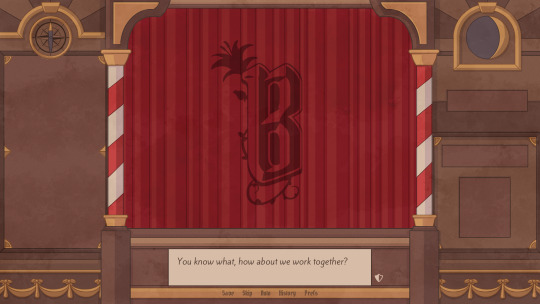
So instead we decided to keep the basic conflict but make the narrator and player collaborate in telling a story both of them are happy with. This immediately made everything more positive and while there's definitely less conflict now, we have planned a few things to still make the most of the theater concept...
Since Act 1 serves to introduce the actual story of the "play" so to speak, the parallel narrative about the narrator is mainly in the background. In the beginning of Act 2 you can already see a few more instances where they directly turn to the audience (or vice versa) but our main focus will still be with the story of the princes. In the coming Acts however, there will definitely be more of these moments to make sure the theater concept isn't just a visual gimmick. But I'll go more into detail on that once you could actually see it all in-game!
Dynamic Personality
Something else we had planned fairly early on, was the fact that Saffron is our first protagonist whose personality the player can directly influence. Because he still takes part in conversations this is only to an extent, but on top of his base personality, there are three distinct nuances of Saffron that you can go for:
Internally we call them "lawful", "daring", and "soft" and pretty much every choice in the game (that isn't just between the narrator and the player) is recorded to keep track of whichever of these is the most prominent in any given playthrough.
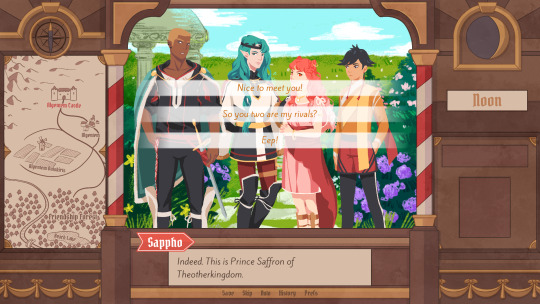
So at various points in the script, we check Saffron's current personality and depending on the result, the story can change. This varies between minor wording differences, whole unique sections of dialogue or narration, or actually different events although the latter is also the rarest case.
In practice, moments in the script where this becomes relevant can look like this (slight spoiler alert for Act 2):
if checkSafAlignment("daring"): saf "Actually, I think I disagree.{w=0.3} You're not just anybody else to me." elif checkSafAlignment("soft"): saf "A-actually, I don't treat everybody like this..." else: saf "Well, everyone deserves respect, regardless how strange they may be."
Essentially Saffron always says the same thing here but when he's daring, it is kind of one of those "This isn't good, it's great" kind of sentences, while his soft version mostly sounds nervous and the lawful one rather rational.
An example for greater variations due to different personalities would be this (also Act 2 spoilers):
menu: saf "W-well uh...{fast}" "I suppose it might be interest~": [...] "I uh, was just checking on you": [...] "*faint*": $setSafAlignment(2) if checkSafAlignment("soft"): "On the spot Prince Saffron fainted, overwhelmed by the other prince's question." [...] else: "Prince Saffron tried his hardest to faint in order to escape the predicament of answering the question." "But unfortunately he only managed to feel a little dizzy."
This second example also shows that even though the choices themselves already have an effect on Saffron's personality, the actual results could still vary depending on previous choices. So in this case, going for the "soft" answer might only work out as expected if Saffron is already soft.
Of course either of these variations have to fit into the general flow of the dialogue and narration and eventually have to return to the main branch, but even so they should make the overall experience more interesting and hopefully also add some surprises to the same events on different playthroughs!
Aside from script variations, Saffron's personality also influences the romance aspect of the game as both Hans and Ode have different preferences and might take more of a liking to a certain version of Saffron.
We don't intend it to be very difficult to romance either of them (after all this is a Marry Tale!) so this takes the form of a bonus and Saffron's personality isn't the main deciding factor for which route you will get.
So yeah, those are about all important things to say on the matter!
We are still in the process of finishing up Act 2, which was a little delayed this week due to administrative work we had to take care of at the studio but we will let you know when we have the release date for it!
We'll be back with another devlog in two weeks, so as always, thank you so much for reading and for your interest in our games <3
8 notes
·
View notes
Text
Wonder Woman #45
Previously in hey, remember when Wonder Woman used to be the protagonist of this comic? Does anyone remember that?
Darkseid wants a powerful army, so he’s decided to enslave the Amazons. He built a Stargate capable of reaching Themyscira, and sent Grail through to conquer it single-handedly. The Amazons, being the incredible army that they are, are completely overwhelmed by this invasion of one, and Grail begins zapping them and turning them into parademons, because apparently that’s something she can do now?? And she never thought to use to turn Diana and Jason into her loyal minions, because reasons???
Diana can’t follow Grail because Robinson — either through not paying attention or not giving a shit — has rewritten canon, and now instead of Themyscira being near-impossible to find by design because it houses Ares’ prison, it’s governed by some weird arbitrary rules around not permitting anybody to return after they leave, except if their feet never touched the ground. This is purely an excuse to send Jason through in Diana’s stead.
So instead, Diana has mostly been punching Darkseid ineffectually while raging about how she hates him and wants to hurt him because he killed her daddy. By the end of this issue, she will have done precisely one thing to impact the plot in this entire arc, and it’s love her daddy so much that his ghost comes and beats up Darkseid for her.
The issue opens with parademonised Amazons pouring out of the portal from Themyscira, and Diana, Steve, Jason and the ARGUS goon squad struggling to fight them off.
Since the New 52 relaunch, the Amazons have — with the exception of Rucka’s year on the book — alternately been turned into beasts, killed people en masse, or been killed en masse. So of course Robinson managed to find a way to incorporate all three. This isn’t something unique to the New 52 — between 1986 and 2011, I don’t think there was a single extended run on Wondy that didn’t involve a mass slaughter of Amazons — but it doesn’t make it any less awful this time.
Robinson’s exposition goes into double-time, as the characters frantically remind each other/us what happened last issue, while simultaneously Steve’s narration boxes remind us what’s happened so far in this arc.
In amongst this, there’s a hilarious moment where an ARGUS soldier runs over to Steve with Diana’s sword, like it’s just found the Holy Grail.
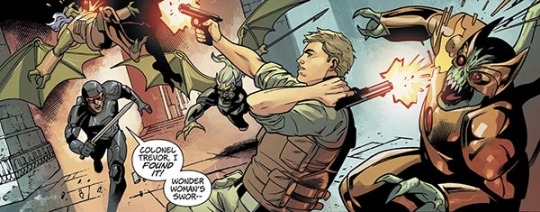
“Colonel Trevor, I found it! Wonder Woman’s swor—!”
Wonder Woman’s sword not some magical super-weapon that’s going to turn the tide of the battle. It’s just a sword, same as the ones the Paramazondemons are using.
You know what is a magical super-item that could turn the tide of the battle? The goddamn Lasso of Truth. You know, unbreakable divine relic? Capable of cutting through illusion and mind control, even self-deception? You don’t think it would be worth trying that on your mind-controlled sisters before you start stabbing them?
But suddenly this perfectly ordinary sword is the most important thing in the world! When the ARGUS goon is impaled from behind and drops the sword, Jason swoops in to pick it up.

“Got it! Sword’s on its way, sister!”
After a brief time out for some more exposition, Jason tosses Diana the sword and flies through the portal (because his feet never touched the ground the first time he was there blah blah).
Jason’s powers still look idiotic, and Temofonte’s lettering choices are still irritating.
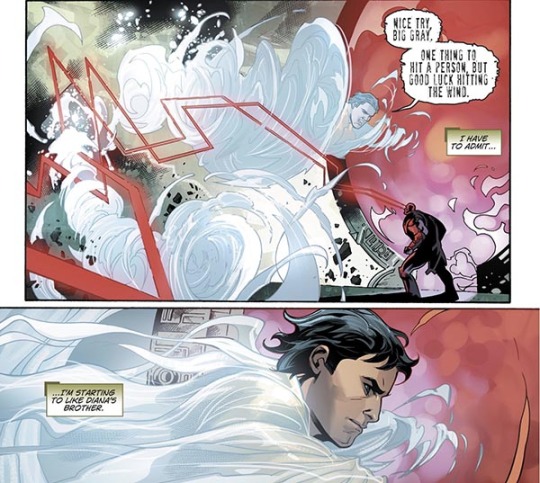
Steve [narration]: I have to admit… I’m starting to like Diana’s brother.
Good lord, why? Since when?!
A couple of hours ago, Steve disliked Jason on account of Jason being a reckless, glory-hounding, dangerously inexperienced, untrustworthy wanker. He spent a lot of time listing all the reasons he didn’t trust him! And all of those things still hold true. Maybe Jason’s taking this fight a little more seriously than previous ones, but he’s still substantially the same person that he was two hours earlier. Realistically, Steve should be less than thrilled that his people’s lives and the lives of the Amazons are in the hands of an untrained, undisciplined, ego-driven turncoat whose recent exploits include henching for Darkseid, trying to kill Diana and acquiring super-powered armour under suspiciously vague circumstances.
Now with that all-important sword in hand, Diana continues to be… pretty ineffectual against Darkseid.
Diana calls Darkseid insane. This is something she’s been doing at least once every issue, and each time she does, it grates on me. Part of it’s the excessively casual use of pejoratives — because even by the standards of the superhero genre, which historically hasn’t been great at handling mental illness and is quick to default to labels like ‘crazy’ and ‘mad’ and ‘insane’, Robinson’s Diana throws these words around a lot, and it’s deeply out of character.
But more than that, it makes no sense, because of all the characters in this godforsaken comic, Darkseid’s behaviour may be the least erratic. His agenda has been consistent from day one: he wants to regain his power so that he can retake Apokolips, and all of his actions have been effectively targeted to take him towards that goal. He’s cruel, ruthless, callous, vicious, dictatorial and arguably evil, but you couldn’t really call him “insane”.
It gets worse, because the reason Diana thinks Darkseid is mentally unstable is that — even having had it spelled out to her three issues ago by Grail under the compulsion of the Lasso — she still can’t figure out what his plan is. “I know you’re insane, Darkseid,” she says, “but this — transforming my sisters into parademons — this madness has no rhyme at all.”
At this stage, Diana knows
Darkseid wants an army — one that is both extremely powerful and unquestioningly loyal (per Grail),
With this objective in mind, Darkseid has gone to great lengths to open a portal to Themyscira, and
Now Grail has gone to Themyscira, where she is turning Amazons into extremely powerful and unquestioningly loyal parademons
…and she still can’t put the fucking pieces together. That’s how checked out of the plot Diana is: we’re ten pages from the end of the arc, and the villain is forced to explain to her what she should have twigged to sixty pages ago.
Jason enters Themyscira and sees Hippolyta fighting Grail. He rushes to her aid, but in a rare non-terrible writing decision from Robinson, his presence is entirely unnecessary: Hippolyta proves perfectly capable of taking down Grail without any help.
Cue the nauseating reunion.
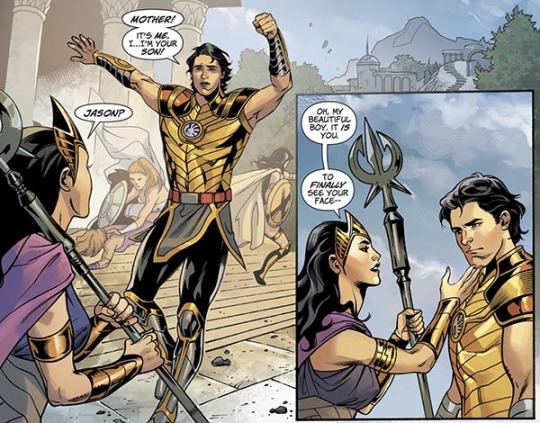
Jason: Mother! It’s me. I… I’m your son!
Hippolyta: Jason? Oh, my beautiful boy. It is you. To finally see your face—

Diana, meanwhile, continues to be completely ineffectual. Battered by Darkseid, she whimpers to Steve that she’s starting to think that she can’t win. Steve tells her that no matter what, he loves her, and Diana sits bolt upright.

“That’s it, Steve! LOVE! Hatred won’t win this — violence — but love just might!”
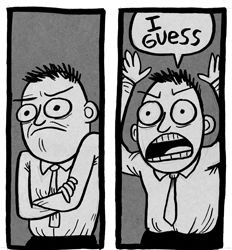
Look, I’m glad that Robinson has finally figured out that Diana’s greatest strength as a hero is the depth of her love and compassion, rather than a propensity for excessive violence — because, hey, better late than never — but this is straight out of left field.
And the annoying thing is, under other circumstances, this plot point — Diana besting Darkseid not through force, but through love — could be done well. Has been done, in fact, fifteen-odd years ago by Phil Jimenez.
Good comics interlude: During the ‘Our Worlds at War’ crossover, Diana has to team up with Darkseid to save the universe. With Raven’s help, she channels her faith and the faith of all her sisters into Darkseid in order to restore his power so that he can blah blah convoluted plot stuff. At the story’s end, Darkseid gloats that he is back at the height of his power, while Diana has lost almost everything — her mother has been killed, along with hundreds of other Amazons. Themyscira is no more. Diana even lost a piece of her very soul to Darkseid through the act of empowering him.
Diana smiles slowly.

“Surely you must be joking, Darkseid? Or don’t you know?
When Raven channelled our energies through you, she infected your dark spirit. She didn’t just give you my power, she used her empathic powers to fuse that part of my soul into your own. A part that I give freely, each and every day… and which you took gladly, without understanding the consequences.
There’s a piece of me inside you now, Darkseid. A piece that believes more than anything in joy and hope and peace. So ponder on that, New God — each and every time your feelings and actions are tainted by some undeniable longing for kindness… or the next time the Fates decide you should commit an unidentifiable act of compassion towards your minions and people in the name of some abstraction called ‘love’. Ponder that.”
SHE INFECTED HIM WITH HER SOUL SHE IS SUCH A FUCKING BOSS.
A year and a half later, Jimenez delivers an insight into just what this means for Darkseid. And while he’s much the same villain as before, there’s a stubborn splinter of pure compassion embedded deep within his soul. It torments and infuriates him. Every so often, it drives him to feel things, do things entirely alien to him — like show mercy to a slave.
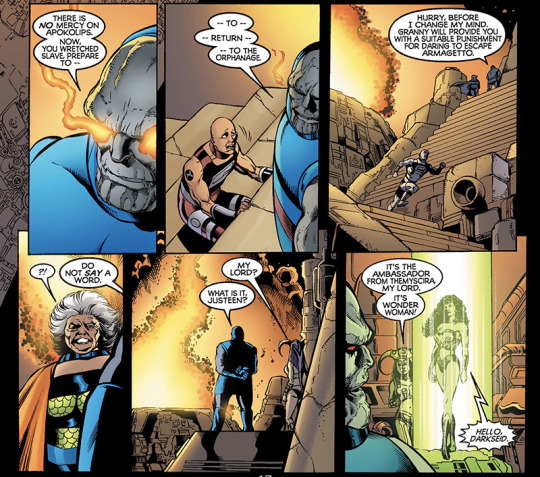

Darkseid: Foul woman! What have you done to me?
Diana: What’s wrong, Darkseid? Had moment or two of inexplicable compassion? I warned you. The portion of my soul you stole will corrupt you from the inside out. You’ll be kissing babies and freeing slaves before you know it.
Darkseid: What do you want, Amazon?
Diana: Just to remind you of your invitation, New God. It seems some of the Amazons are actually willing to forgive you for your hateful transgressions against them and would like to negotiate a more peaceful relationship with the Lord of Apokolips. You should come. Who knows? You might even learn a thing or two. Although it seems to me you’re learning plenty right now…
Darkseid: [raging] AAAAAHHHHHHHH!
That’s how Diana owned Darkseid with the power of love last time.
And this is how Robinson’s Diana… enables Zeus’s ghost to own Darkseid on her behalf through the power of her love for her daddy:
Her boyfriend says ‘I love you’, and this gives her an idea. She walks up to Darkseid and informs him that she’s not going to fight, she’s just going to let him pummel her while she aggressively loves Zeus at him. This causes the ghosts of all the gods Darkseid devoured to to pour out of him. Zeus manages to stick around long enough to tell Diana that he’s proud of her, then fades away while Diana’s all ‘noooo daddeeeee come baaaack’. Then Darkseid appears to spontaneously combust, the end.

Steve points out that whatever happened to Darkseid has affected the portal as well — it’s now closing, with Jason and Grail still on the other side.

On Themyscira, the Amazons have just about contained their parademonised sisters, when they see that the portal is closing. Cue another nauseating scene of Hippolyta waxing emotional over how much she loves Jason and he’s the best son ever and, here, have this super-special magical god-weapon, why don’t you?
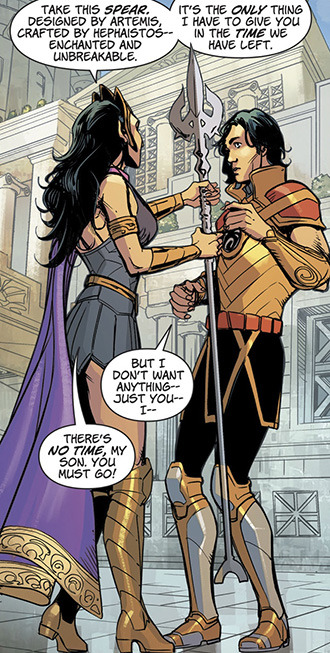
“Take this spear. Designed by Artemis, crafted by Hephaistos — enchanted and unbreakable.”
boo.
Steve and Diana wait anxiously by the Totally-Not-A-Stargate.

Steve: So what do you want me to do, Angel? I mean, you can’t go through, obviously… but I could.
What are you talking about, no you bloody couldn’t!
Robinson has been quite clear about the portal rules. They’re dumb rules, and they fly in the face of established canon, but they’re clear.
If you have ever been to Themyscira before, you cannot enter the portal.
You only register as having been to Themyscira if your feet touched the ground.
Steve has been to Themyscira. His feet touched the ground. You cannot go changing up the rules with only four pages to go.
But of course Jason gets back just in time, and Diana is unrealistically excited to see him, and it’s all, ‘I met my mummy and she loves me!’ ‘I met my daddy and he loves me!’ ‘Oh PS, we’ve got a bunch of parademon-Amazons in custody now. I guess maybe somebody should work on turning them back to normal?’
Grail wakes up chained in Ares’ prison. At a cursory glance, this seems like a reasonable solution: Grail is a prisoner, and no prison is more secure than the one Themyscira guards over.
But then, unlike Robinson, I thought about it for more than a second and what the hell this is a terrible idea. The whole point of Themyscira is to prevent anybody who might conspire to release Ares on the world from reaching his prison, and they’ve just locked a supervillain in with him and his evil sons. Unleashing War on the world is exactly the kind of thing Grail would do if it means securing her escape and furthering Darkseid’s plans.
It’s also a dick move on the Amazons’ part, because Grail is supposedly one of their own. She has a lot to atone for, and there would undoubtedly be Amazons who’d want to see her pay for her crimes, but I doubt it would escape the council’s notice that Grail has essentially been used and manipulated by trusted parental figures for her entire life. Her mother bore her, raised her and trained her to be a weapon whose only purpose was to destroy Darkseid. Her father turned her into his loyal minion. She has never been her own person, never had any family that didn’t see her as a means to an end. Surely the Amazons would ultimately see it as their responsibility not just to punish and contain her, but to rehabilitate her. That can’t happen if she’s locked away in a cave with only Ares for company.
Also, you know, she’s probably the best chance they have of curing their parademonised sisters, so… maybe do something about that as well?
Meanwhile, somewhere on Earth, Darkseid is wandering around, naked, human-ish, and amnesiac; the end.
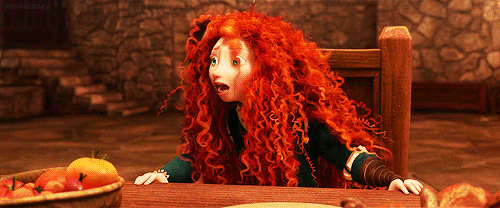
15 notes
·
View notes
Conversation
INTRODUCTORY COURSE MATERIAL pt. 3
First person or participant point of view: The participant point of view is also called first-person point of view because first-person pronouns (I, me, my, we, us, our) are used to tell the story.
The first person/participant point of view can be further subdivided into two types: 1. the narrator as a major character - the story is told by and is chiefly about the narrator. 2. the narrator as a minor character - the narrator tells the story that focuses on someone else, but the narrator is still a character in the story.
Advantages of First Person Narration: It allows the writer to bring his or her reader as close to the emotions and thoughts of the narrator as is possible. This often allows the reader to make direct contact with the narrator.
Disadvantages of First Person Narration: It limits the reader's understanding to only what is experienced by the first person narrator. First-person points of view are limited to what the first-person narrator himself/herself knows, experiences, infers, or can find out by talking to other characters.
Second Person point of view: In second person point of view, the story is told using "you", the second person pronoun
Advantages of Second Person Narration: Second person narration creates a feeling of immediacy. It is often used to heighten tension.
Disadvantages of Second Person Narration: Commands the reader's attention.
Third Person Point of View (Limited or objective): This point of view tells the story from the vantage point of the third person pronoun - he, she, it and they. This point of view allows the reader to understand events from one character's perspective. Everything that happens in the story is understood by the reader through the experiences and reactions of one character.
Advantages of Third Person Narration: It gives the writer the opportunity to place the character close to the reader. In this sense, it is like first person point of view. At the same time, it allows the reader to experience the reactions of other characters without being confined to the experience of the main character alone. We can observe other character's reactions to the main character independently of the main character.
Disadvantages of Third Person Narration: It still limits the reader to the experience of one character since we cannot enter the mind or persona of any other character. At best, we can judge reality by the way other characters respond to the main character.
Third Person Point of View (Omniscient): Only difference from the limited/objective third person point of view is that readers have full knowledge of all characters and situations, rather than just one character and his/her experiences.
Advantages of Omniscient Narration: The reader is able to enter the minds of any number of characters in this omniscient or "all-knowing" point of view. This gives the writer the 'god-like' ability to move from consciousness to consciousness as each character experiences the same or even different events in a story. The writer can also add some commentary as in "At last she had found justice," which appears to come from a source outside a character. This point of view even allows an author to tell his or her reader about events which some characters could not possibly know about as in the events that will unfold in Rita's kitchen.
Disadvantages of Omniscient Narration: This technique is often best suited to longer pieces of literature such as novellas or novels. This point of view can be somewhat artificial if the narrator makes too many additional comments. Writers using this point of view should not focus equally on each character since this would be confusing. Usually it's best to allow your reader an insight into the mind of the main character and a few other important characters.
A Final Point of View - The Unreliable Narrator: One who cannot be trusted because his or her interpretation of incidents or individuals does not coincide with what really happened. Often the hallmark of this kind of narration is the narrator as a flawed and distorted centre of consciousness. The narrator is incapable of seeing things as they really are; it is left to the reader to see beyond the narrator to the truth. The unreliable narrator can be either first, second or third person in nature.
Notes taken from EWC4U: The Writer's Craft, Grade 12, University Preparation, Unit 1: Writers tool box
0 notes
Photo
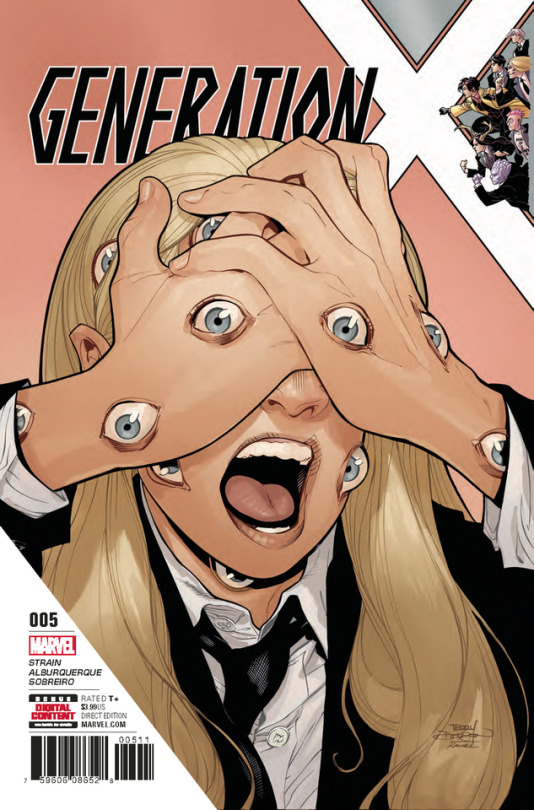
GENERATION X #5 REVIEW **SPOILERS**
Writer: Christina Strain
Artist: Alberto Jimenez Alburquerque
Colorist: Felipe Sobreiro
Letterer: VC’s Clayton Cowles
Cover Artists: Rachel Dodson, Terry Dodson
Publisher: @marvelentertainment
NCBD: 8/16/17
Review by: Anthony Mullins ( @antwonito )
SUMMARY:
During a test of skills with Jubilee, Eye-Boy’s abilities begin to run haywire. We learn that some personal items around the school have gone missing, and Eye-Boy reveals his problem to Lin (Nature Girl), the only person unaffected by whatever is happening to his sight. After witnessing a robbery, Eye-Boy and Nature Girl head deeper into the park, where the park’s wildlife reveals a grand scheme of tyranny unbeknownst to the world around it.
REVIEW:
Particularly following Eye-Boy throughout, we see him struggle with losing control over his abilities. This grants an unfamiliar reader with further insight as to how his abilities function, while developing the potential of his abilities. Done in a smart and entertaining way, we are able to better understand past knowledge while expanding on it in the process, all wrapped up in a story that lets the reader become more familiar with a character. Furthermore, the entertainment of the issue is increased by the more human aspects of Eye-Boy that Strain presents the reader with, learning the way he thinks and views the world through his abilities and his narrated thoughts. Being able to blend such obscure characters and tones with a more human approach lends a unique relatability for the reader. We see Eye-Boy’s insecurity in his thoughts, yet see him flourish in rallying animals in a forest to obtain their freedom - the duality and development present help shape Eye-Boy’s courage and potential.
Nature Girl also shines within this issue, lending Eye-Boy a hand in his side quest. These two have been together in past series; it was fun to revisit their dynamic and develop it for a newer audience. Nature Girl is the only one that Eye-Boy’s erratic sight remains intact for, showing us how different the two are in his struggle to understand Lin on a deeper level. After the two team up and rectify the situation within the forest, they discuss the tale of their journey. Nature Girl is affected, upset, by her actions in attacking Eye-Boy under The Rat King’s influence. Trevor and Lin decide to keep the details of their adventure between themselves, showing how close the two have grown in that they are able and willing to compromise to help keep Lin’s reputation safe. This shows a lot of heart on Trevor’s part - their adventure helps display him as a brave and heroic character, yet he is willing to downplay his actions for the sake of making Lin happier. At the start of this series, I underestimated Trevor’s bravery and strength, but this issue helps define him as a force to be reckoned with, teaching us that even the most seemingly strange person can be a hero when they put their heart in to their goals.
Through Trevor’s perspective, and with the use of his abilities being on the fritz as a story device, we see the rest of the team interacting as well. We catch a moment of Trevor hanging out with Nathaniel and Benjamin while the two talk about movies, and a scene of Jubilee and Chamber comforting a sad Roxy; these small aspects from Eye-Boy’s perspective give us insight to the group growing as a family of sorts, and offsets the tension of the previous issues with a slice of normalcy at the Institute. It was also a lot of fun to see the students gather for lunch, it really felt like the kind of high school lunch table experience from childhood, but with mutants instead (plus it was a lot of fun to see other familiar and previously present X-Men members in the background). Trevor gives a motivational speech to the animals of the forest, and I felt the zany and humorous tone was delivered so well! The most meta humor in this issue was with Eye-Boy commenting about The Rat King being a d-list villain and not caring about his backstory - it was just another way to better endear Trevor, and it was comedically unexpected.
Alburquerque takes over on art for this issue. There are definitive differences from Pinna’s work in previous issues, but it still maintains a quirky and offbeat style and tone within every page. This issue develops certain smaller plot points and themes leading up to it but generally acts foremost as a side story of sorts, making the art switch up flow more seamlessly. Strain’s writing and dialogue lend a whimsical and underdog tone to the story. Paired with Alburquerque’s visuals, the two create an exciting viewpoint for the character of Eye-Boy. From the way Eye-Boy’s abilities are presented to the interactions he has throughout, there is a relatable tone in struggling with insecurities and public opinion that is told to the reader in a very fun and upbeat style.
OVERALL:
While Alburquerque’s art on this issues adds a unique flair, Christina Strain’s writing continues to thread the series together in tonal clarity and with smart dialogue. With focused development on a couple particular characters who may be less familiar to the reader, we still gain glimpses of the teams interactions as a whole with slight nudges towards the family style sanctuary that the school can offer its students. For being a calm before the storm of sorts (the next issue is the first arc’s end), this was a really fun read that helped create layers to the Institute and the relationships involved within it. Major props to Christina Strain for continuing to think out of the box with her style of storytelling.
8/10
Hear more discussion of Generation X #5 on the X-Men Monday Podcast, here.
#generation x#x-men#x-men comics#eye boy#nature girl#jubilee#christina strain#alberto jimenez alburquerque#felipe sobreiro#rachel dodson#terry dodson#marvel comics#marvel
3 notes
·
View notes
Photo

Secret Empire #6
...Spencer made a bold move on this one. Not what I was expecting at all, considering the cover and the hinting set ups of last issue. On the reread, I still can’t believe that ending... But Hey. I guess that’s what this Event is all about. Bleak, dismal times.
I have a vague idea on how this is all gonna go down now, and I won’t give it away here. All I’ll say is, damn... Looks like we really do need that Cosmic Cube after all...
[SPOILERS]
Alright. Here I’ll hold nothing back.
First thing’s first. Mysterious Rogers:
We start in that forest we’ve been seeing him in. He’s tied up with another rando, who’s got a screwed up large eye. He’s probably insignificant, as he's done away with rather quickly by the Red Skull. Then he tells Rogers that he’s next.
[But last we checked, he said he could get him out of here. I guess he meant through death?]
The big reveal a little later is that apparently they’re in Hell. [I don’t know... how that works. I started to think this was maybe a subconscious brain thing..? But I really have no idea. As Hydra Cap is obviously walking and talking on the real physical plane just fine.] ...Is this supposed to be an embodiment of his conscience that’s struggling to be free or something?? I just don’t know. Skull’s interactions with him are interesting though.
New York:
We get some more insight on how much keeping the City alight is taking it’s toll on Dagger. Night Nurse is with her and she gives her something to help, but Cloak is worried that whatever it is, it isn’t working anymore.
Meanwhile, we get to see Stephen Strange use some sweet magic as he walks through a Library and converses with an alien known as the Librarian(?) [This must be an old-school reference]. When they greet one-another, he mentions that, “I thought you were too good for us lowly collectors... years ago...”
Anyway, Strange goes to him to learn a big light spell that will get them out of this darkness. [Hmm.. Don’t know how I feel about that.]
Meanwhile, Daredevil intercepts Fisk and some goons only to find that he was actually helping people with crates of goods. He asks Kingpin what his game is, and Wilson holds nothing back. Once all of this is over, the people will remember what he did for them and they’ll trust him to Lead the City.
[Hmm. Mayor Fisk anyone?]
Maryland:
Nadia quits the Underground Red Room team. Miles tries to talk her out of it. Viv and Joaquin (the new Falcon) say that this situation isn’t so black and white, and that they should sort of stay the course and see what happens.
Then, Miles spends a long time trying to talk to Black Widow, who in my opinion shouldn’t even give him the time of day. But she listens to him as he sort of asks, whys he keeps them in the dark, and that she’s gotta be rooting for the Cosmic Cube hunters a little bit. Right??
He also asked about that old man they rescued and she told him that was none of her concern. [I’m tellin you, that’s Nick Fury Sr. But that’s just me.]
The Mount:
The attack begins. Thor goes in and yells “FORGIVE ME!!!”, which was kind of cool to see, while Cap narrates all sorts of shit about how the Underground had this coming.
We find that he’s talking to Bruce Banner the whole time, who was our reveal at the end of the last issue. And what Bruce responds to that is golden.
But first... inside the secret compound, there is internal strife within. Tony A.I absolutely figures out that it was Bobbi who let them know that they were here. There is a short dispute with Pietro as well, as Bobbi tried to pin the suspicion on him to cover her ass. [He did constantly disappear on their missions to look for his sister.] Tony A.I isn’t so iron clad though, himself, as Raz reveals that he’s been holding out on them as well.
So... with our heroes coming to a distrusting rift once again, we go back to Cap who is basically filling in Banner about where they stand and what he needs Hulk to do.
But Banner says, ‘FUCK NO!’ In way more words.
I loved his stance on everything. The complete outsider, completely called out Cap for being a fucking Fascist sellout. “Maybe that became fashionable while I was out. But last I checked, you’re the evil fascist totalitarian bad guys...”
He admitted to having anger and resentment toward his peers. But he said he’d handle that in his own way, with strong words. But he’d never Hulk out on them. “I’m still an Avenger, dammit. And if that’s a problem? Then you can just go ahead and put me back in whatever box you pulled me out of. Because honestly-- it’s been a very long time since I slept that well.”
[Whoa!! That was amazing.]
,,,The infighting at the Mount stops when the Hulk is HYPNOTIZED and breaks through their fortified barriers.
...and I would’ve loved this issue, had it ended there. But it didn’t.
We see some sweet panels of Hulk rampaging, and Clint falling to his knees, defeated. He’s ready to accept death here, but the Thing steps up and tries to fight the Hulk. “--IT’S CLOBBERIN’ TIME!”
He gets laid out rather quickly though.
Bobbi saves Clint (and I guess she’s not a complete traitor after all.) This was almost touching. They don’t really interact much lately, but you need to remember that that’s his ex-wife. Anyway, she basically sobers him up and Clint acts like a Hero again. He shakes it off and directs the civilians among his compound to safety.
Meanwhile, Raz - the new Giant Man talks to Rayshaun. And reveals that he apparently has a team of Android Avenger duplicates of Steve Rogers, Jane Foster Thor, Clint and Miles... [This... did not do it for me.]
More action panels go by, and we actually get a really nice moment from Odinson, who stands before Clint, Bobbi and Tiger, who are protecting a bunch of citizens.
He just grits his teeth and says, “Go.” Allowing Clint to let the people evacuate safely.
[This gives me a lot of hope for what’s to come.]
Sam Wilson and Bobbi get in a jet, and I guess they leave.
Then we get a lot of focus on an Iron Man and Cap rematch.
And it’s really cool and climactic to see. It’s Civil War fuckin’ III up in here. We find that the Tony A.I can somehow feel pain.
And somehow Cap is able to kill Tony with his shield, as he goes for a final beheading blow.
But instead, Elisa intervenes and teleports Steve out of there.
“Goodbye, Son.”
She says as the whole place blows up in a Nuclear explosion.
...What the Hell just happened!!!?
On the last page, there’s news that Natasha hears over the radio.
“Breaking News out of Nevada as Hydra troops launched a major surprise attack against Underground Forces, with reports that the subversives’ secret base has been destroyed. No word on survivors.”
She pours a drink and cries.
Then she tells all of the teenagers to wake up with a stone cold face.
“Hydra has won. Our friends are all dead. Tomorrow we kill Captain America.”
-To Be Continued!-
What. The. Fuuuuuuuuck!!!!!????
That ending shocked and upset me so much.
But I guess I got used to it now.
...The only small hope I have is that Odinson cooperated with them. Now I’m hoping that Hydra can collapse from within. And that Sam Wilson and Bobbi escaped at least...
I don’t know. There’s still a lot going on, but SO many major players have just been laid out. And it’s really pretty fucked up.
Until Secret Empire #7, which is apparently coming out tomorrow!?
2 notes
·
View notes
Text
Break Free B2B Marketing: “Webinerd” Mark Bornstein of ON24 on Dialing In Digital Experiences
Like many other digital experiences, the webinar has traditionally been viewed as a means to an end: Create something that seems valuable to your audience, and use it as a vehicle to acquire contact information for lead generation purposes. But marketers like Mark Bornstein take a different angle: What if we view the webinar itself as an end — an extremely valuable marketing tool on its own? What if we’re just muddying it up with all these mandatory form-fills and sales-y follow-ups? “You need the name once, you need the demographic information one time,” he observes. “But why do we keep putting forms together again and again? What matters is the experience.” [bctt tweet="“Why do we keep putting lead gen forms together again and again? What matters is the experience.” — @4markb on #BreakFreeB2B #DigitalExperiences" username="toprank"] Mark elaborates: “It's the experience you give, it's the way you're able to connect and interact with audiences that matters. Because that's where you're going to get the real data. That's where you're going to learn a lot about them.” Although he is a proud marketer, and VP of Marketing for the webinar solution provider ON24, this self-professed “webinerd,” Mark urges his fellow practitioners to develop a new mindset by moving away from traditional terminologies: “It's not about marketing anymore. It's about connecting people to your brand. It's relationship-building.” The days of dry, facelessly narrated slide presentations are gone, he argues. We need to dial in and focus on human connections through authenticity, empathy, and compassion. We need to learn more about our customers than how we can contact them with follow-up promotional materials. At a time where physical events and meetings are off the table, achieving these connections in the digital space via experiential marketing has never been more vital. In his 25-minute conversation with TopRank Marketing’s Susan Misukanis at B2B Marketing Exchange in February, Mark shared a wealth of insights, which have only become more useful and valuable in the weeks and months since.
Break Free B2B Interview with Mark Bornstein
youtube
If you’re interested in checking out a particular portion of the discussion, you can find a quick general outline below, as well as a few excerpts that stood out to us.
0:45 - Mark's experience making webinars, and his view on lead gen
2:00 - Have we reached the end of MQLs?
3:15 - What is an experience and what makes a good one?
5:00 - Examples of companies that are getting digital experiences right
7:45 - What role will technology play in experiences going forward?
10:00 - Are brands becoming more open to moving outside the box?
12:00 - Finding and positioning your brand's narrative
13:30 - Getting back to opt-in marketing fundamentals
16:00 - Where Mark sees the industry going in 2-3 years
17:30 - Who is poised to win in the short-term (SMB/verticals vs. enterprise)?
20:15 - The value of compassion, empathy and connection
24:15 - How can B2B marketers break free?
Susan: So you talk about an experience ... Can you take it a level deeper? What is an experience? Mark: Well, let me tell you about my world. So in the world of webinars, if you think about what a webinar was even a few years ago — and maybe in some cases still now — the webinar was a talking PowerPoint. Just a headless voice, you didn't see anybody. You just heard somebody going through the slides in a droll way and it wasn't branded and it was just boring. And maybe a lot of webinars still are kind of boring. But the fact of the matter is, what we see companies doing now is they're creating serialized programming. They're creating these really cool almost TV-like viewing experiences, where it's a show and there's hosts and the formats are changing. There's panel discussions and coffee talks and chat shows and new style formats. So companies that are trying to own thought leadership, to establish a voice, to be the company that people go to — they’re not going to do that through giving a webinar on, you know, here's our content. Here's our slide presentation. They're doing it by building experiences. And I think a really great experience has a few of the following qualities: It should be completely branded. It should be interactive. I always say give yourself the “what can they do?” test. When somebody is experiencing your content, is this all they can do? They’re reading your ebook or watching your video … is that it? An experience is a place where people can ask questions, or they can chat, or they can tweet, or they can download content. They can click on CTAs. You want to create an environment where people are doing stuff, and it's a multi-touch content experience. And so it's a different thing today. [bctt tweet="“Companies that are trying to own thought leadership, they’re not going to do that through giving a webinar that’s a slide presentation. They're doing it by building experiences.” — @4markb on #BreakFreeB2B #DigitalExperiences" username="toprank"] Susan: We keep hearing that marketing is moving toward AI and tech — in a few years, it'll all be bot-driven. How do you reconcile that with your vision? Mark: One of the things that drives me crazy about marketing in general is that we as marketers are very interesting creatures, in the sense that we're always willing to try new things. But we also get into habits we can't break. And a lot of the technologies — whether it's automation, or artificial intelligence, predictive analytics — all these amazing technologies that have been created to scale our marketing in ways like never before? Well, we are acting like this technology that was created to get people to our marketing has now become our marketing. So you need to look at, you know, artificial intelligence tells us out of this vast infinite number of people who we should be targeting, and maybe some of the topics we should be talking about. We can get a lot of great information. Automation allows us to scale that up in a lot of different ways. But ultimately, there is a moment of engagement. There still is that human engagement. And so all of that technology can inform, but ultimately, what really has to drive that engagement is the conversation that you have with them and the experience that you can deliver.” [bctt tweet="“We are acting like this technology that was created to get people to our marketing has now become our marketing.” — @4markb on #BreakFreeB2B #DigitalExperiences" username="toprank"] Susan: You tweet a lot about marketers not asking for proper permission to opt in. So maybe our prospective buyer has a need, but getting that opt-in and going about it the right way, that’s a big hurdle. Mark: It is. I mean, if you're a marketer in the U.K., you know what this pain feels like. I think especially in the U.S., but really around the globe, marketers are not ready. I don't think they're taking this seriously enough. You know, privacy legislation is in the U.S. now, but it's mostly based on privacy protections. It's not based on opt-ins and that sort of thing yet. It is coming. It is going to happen very soon, people. And so we need to prepare for this, which means we need to build our marketing around this idea of people opting in. So how do we do this? We have to be able to produce streams of programming that people will want to subscribe to, right? It's no longer about nurtures, it's no longer about ‘can you come to my event’ or ‘will you come to this one-off virtual experience or webinar,’ whatever it is. We need to find ways to get people who want our marketing to opt into our marketing. At a time when all of this digital noise is scaring them away. We need to bring them back in through more authentic, more human, more experiential marketing. We're going to get them there.” Stay tuned to the TopRank Marketing Blog and subscribe to our YouTube channel for more Break Free B2B interviews. Here are a few interviews to whet your appetite:
Break Free B2B Marketing: Sruthi Kumar on Creating Memorable Experiences
Break Free B2B Series: Hal Werner on the Intersection of Marketing Creativity and Analytics
Break Free B2B Series: Adi Bachar-Reske on Taking the Lead in the Evolution of B2B Content Marketing
from The SEO Advantages https://www.toprankblog.com/2020/05/break-free-b2b-marketing-mark-bornstein-on-dialing-in-digital-experiences/
0 notes
Text
Break Free B2B Marketing: “Webinerd” Mark Bornstein of ON24 on Dialing In Digital Experiences
Like many other digital experiences, the webinar has traditionally been viewed as a means to an end: Create something that seems valuable to your audience, and use it as a vehicle to acquire contact information for lead generation purposes. But marketers like Mark Bornstein take a different angle: What if we view the webinar itself as an end — an extremely valuable marketing tool on its own? What if we’re just muddying it up with all these mandatory form-fills and sales-y follow-ups? “You need the name once, you need the demographic information one time,” he observes. “But why do we keep putting forms together again and again? What matters is the experience.” [bctt tweet="“Why do we keep putting lead gen forms together again and again? What matters is the experience.” — @4markb on #BreakFreeB2B #DigitalExperiences" username="toprank"] Mark elaborates: “It's the experience you give, it's the way you're able to connect and interact with audiences that matters. Because that's where you're going to get the real data. That's where you're going to learn a lot about them.” Although he is a proud marketer, and VP of Marketing for the webinar solution provider ON24, this self-professed “webinerd,” Mark urges his fellow practitioners to develop a new mindset by moving away from traditional terminologies: “It's not about marketing anymore. It's about connecting people to your brand. It's relationship-building.” The days of dry, facelessly narrated slide presentations are gone, he argues. We need to dial in and focus on human connections through authenticity, empathy, and compassion. We need to learn more about our customers than how we can contact them with follow-up promotional materials. At a time where physical events and meetings are off the table, achieving these connections in the digital space via experiential marketing has never been more vital. In his 25-minute conversation with TopRank Marketing’s Susan Misukanis at B2B Marketing Exchange in February, Mark shared a wealth of insights, which have only become more useful and valuable in the weeks and months since.
Break Free B2B Interview with Mark Bornstein
youtube
If you’re interested in checking out a particular portion of the discussion, you can find a quick general outline below, as well as a few excerpts that stood out to us.
0:45 - Mark's experience making webinars, and his view on lead gen
2:00 - Have we reached the end of MQLs?
3:15 - What is an experience and what makes a good one?
5:00 - Examples of companies that are getting digital experiences right
7:45 - What role will technology play in experiences going forward?
10:00 - Are brands becoming more open to moving outside the box?
12:00 - Finding and positioning your brand's narrative
13:30 - Getting back to opt-in marketing fundamentals
16:00 - Where Mark sees the industry going in 2-3 years
17:30 - Who is poised to win in the short-term (SMB/verticals vs. enterprise)?
20:15 - The value of compassion, empathy and connection
24:15 - How can B2B marketers break free?
Susan: So you talk about an experience ... Can you take it a level deeper? What is an experience? Mark: Well, let me tell you about my world. So in the world of webinars, if you think about what a webinar was even a few years ago — and maybe in some cases still now — the webinar was a talking PowerPoint. Just a headless voice, you didn't see anybody. You just heard somebody going through the slides in a droll way and it wasn't branded and it was just boring. And maybe a lot of webinars still are kind of boring. But the fact of the matter is, what we see companies doing now is they're creating serialized programming. They're creating these really cool almost TV-like viewing experiences, where it's a show and there's hosts and the formats are changing. There's panel discussions and coffee talks and chat shows and new style formats. So companies that are trying to own thought leadership, to establish a voice, to be the company that people go to — they’re not going to do that through giving a webinar on, you know, here's our content. Here's our slide presentation. They're doing it by building experiences. And I think a really great experience has a few of the following qualities: It should be completely branded. It should be interactive. I always say give yourself the “what can they do?” test. When somebody is experiencing your content, is this all they can do? They’re reading your ebook or watching your video … is that it? An experience is a place where people can ask questions, or they can chat, or they can tweet, or they can download content. They can click on CTAs. You want to create an environment where people are doing stuff, and it's a multi-touch content experience. And so it's a different thing today. [bctt tweet="“Companies that are trying to own thought leadership, they’re not going to do that through giving a webinar that’s a slide presentation. They're doing it by building experiences.” — @4markb on #BreakFreeB2B #DigitalExperiences" username="toprank"] Susan: We keep hearing that marketing is moving toward AI and tech — in a few years, it'll all be bot-driven. How do you reconcile that with your vision? Mark: One of the things that drives me crazy about marketing in general is that we as marketers are very interesting creatures, in the sense that we're always willing to try new things. But we also get into habits we can't break. And a lot of the technologies — whether it's automation, or artificial intelligence, predictive analytics — all these amazing technologies that have been created to scale our marketing in ways like never before? Well, we are acting like this technology that was created to get people to our marketing has now become our marketing. So you need to look at, you know, artificial intelligence tells us out of this vast infinite number of people who we should be targeting, and maybe some of the topics we should be talking about. We can get a lot of great information. Automation allows us to scale that up in a lot of different ways. But ultimately, there is a moment of engagement. There still is that human engagement. And so all of that technology can inform, but ultimately, what really has to drive that engagement is the conversation that you have with them and the experience that you can deliver.” [bctt tweet="“We are acting like this technology that was created to get people to our marketing has now become our marketing.” — @4markb on #BreakFreeB2B #DigitalExperiences" username="toprank"] Susan: You tweet a lot about marketers not asking for proper permission to opt in. So maybe our prospective buyer has a need, but getting that opt-in and going about it the right way, that’s a big hurdle. Mark: It is. I mean, if you're a marketer in the U.K., you know what this pain feels like. I think especially in the U.S., but really around the globe, marketers are not ready. I don't think they're taking this seriously enough. You know, privacy legislation is in the U.S. now, but it's mostly based on privacy protections. It's not based on opt-ins and that sort of thing yet. It is coming. It is going to happen very soon, people. And so we need to prepare for this, which means we need to build our marketing around this idea of people opting in. So how do we do this? We have to be able to produce streams of programming that people will want to subscribe to, right? It's no longer about nurtures, it's no longer about ‘can you come to my event’ or ‘will you come to this one-off virtual experience or webinar,’ whatever it is. We need to find ways to get people who want our marketing to opt into our marketing. At a time when all of this digital noise is scaring them away. We need to bring them back in through more authentic, more human, more experiential marketing. We're going to get them there.” Stay tuned to the TopRank Marketing Blog and subscribe to our YouTube channel for more Break Free B2B interviews. Here are a few interviews to whet your appetite:
Break Free B2B Marketing: Sruthi Kumar on Creating Memorable Experiences
Break Free B2B Series: Hal Werner on the Intersection of Marketing Creativity and Analytics
Break Free B2B Series: Adi Bachar-Reske on Taking the Lead in the Evolution of B2B Content Marketing
Break Free B2B Marketing: “Webinerd” Mark Bornstein of ON24 on Dialing In Digital Experiences published first on yhttps://improfitninja.blogspot.com/
0 notes
Photo

Great background with a great story
Chances are that, if you are a Death Note fan, you are craving a continuation of this amazing series. Death Note: Another Note is set before the famed series. The premise of the story is that Mello, who readers will know from the original series, wrote a book detailing one of the three stories the famous L told him about his past.
Go to Amazon
We all know the story is good, so I'll review the specs of the physical ...
We all know the story is good, so I'll review the specs of the physical book. The pages are the softest pages I've held between my fingers in my entire life. I love them. I also like the cover, and how it was designed. (The black part of the cover is fabric)
Go to Amazon
Amazing book
This book is of the highest quality. It is beautiful in every way. Other than the cover jacket getting jacked up in shipping I have no complaints! If you are a fan of Death Note then you need to own this book!!
Go to Amazon
To Crack an Impossible Case, You Have to Think Outside the Box
Death Note: Another Note - The Los Angeles BB Murder Cases is an companion novel to the hit TV show Death Note following Naomi Misora as she works with a mysterious detective named Ryuzaki as they tackle the seemingly impossible BB murder Cases and put a stop of the mysterious killer whom we come to learn as Beyond Birthday. This novel brings more understanding to the characters that we met in the show and even gives you an insight to the briefly mentioned serial killer named Beyond Birthday.
Go to Amazon
Great, but read the manga first...
This really exceeded my expectations. This book is a rather good one for only being a side story and was very well written. I would recommend reading this if you are a death note fan. Even though this is technically a prequel to the Death Note series, i suggest watching the anime or reading the manga first. The book is more enjoyable if you have some kind of prior knowledge about some of the characters. The book does not develop a lot of the characters as much as it should. So even though this book is dependent upon the series that spawned it to be enjoyed, it is still enjoyable to anyone familiar with the material.
Go to Amazon
Beautiful book, great story!
Amazing book! Can’t put it down! If you are a fan of Death Note, and especially of L, this is a must-have. For the beautiful quality of the book, I found the price to be very reasonable. I posted some pics of the outside of the book, as well as a couple of the opening pages - just reading those will make you want this book if you love L! Narration by Mello.
Go to Amazon
Read it after reading the manga
Go to Amazon
A worthy read for readers who miss Death Note
When I first received the book, I was a little shocked that it was actually a reading book and not a comic-like manga. Not that that's a bad thing, I was just used to reading the Japanese-style stuff. However, it did not stop the book from being pretty interesting.
Go to Amazon
It was in very good shape when I received it
Quick delivery
Five Stars
Five Stars
Five Stars
Any living fan of the mind bending and thought provoking ...
Great read!
Five Stars
Five Stars
0 notes
Text
NieR: Automata Ought to Matter
And not just because of my horribly cheesy puns. Do a quick check on the internet - some reviews on Metacritic, a few YouTube videos - and you’ll get the impression that a lot of people were taken aback by the quality of the game. NieR, the original game released in April of 2010, didn’t do so well. It gained a cult following for a handful of reasons that I’ll address later, but the overall consensus suggested that the game wasn’t anything special. Poor combat, lacking visuals and repetition were the most commonly cited problems from review outlets such as IGN and Kotaku. Then along comes an announcement from Square Enix that NieR was in for a sequel and everyone was just a little bemused.
I say all this without having had the benefit of first hand experience. I was an initiate to Yoko Taro when I first plunged into NieR: Automata. Like a lot of others, I picked up the game on the assurances that followed reviews of the sequel. This one was different, they said. Different in a lot of ways. And one of the reasons for that was Platinum games.
Platinum. The studio that focused on action combat games like Bayonetta. Their combat systems sought to provide fun and entertainment, with enough depth for gamers to sink their teeth into should they wish to really understand the mechanics. Their previous games received rave reviews (well… let's forget that one Teenage Mutant Ninja Turtles title. Everyone tries to) so naturally, interest had sparked in their new collaboration before it was even released. Whilst the team up ultimately paid off, there was a sense of trepidation towards the other party.
Here’s where things start to get a little more… different. So you have a studio known for their excellent combat and a game director whose previous game in the same series was criticised for having dull combat. You’ve got the one thing needed to plug up the leak in an otherwise study ship right? All fine, except that ship is steered by Yoko Taro, and this captain likes sailing over rocks just to see how much damage he can do. Damage, in this sense, would be the emotional kind. NieR: Automata thankfully doesn’t suffer at all for Taro’s tendency to go off the map. In fact, that’s when it flourishes. Platinum games provide the base for which a story can be built, in which everything weaves around it perfectly.
When Yoko Taro spoke at the 2014 Games Developers Conference, he made a point of how he writes his stories: “Backwards script writing and photo thinking” he calls them. Backwards scriptwriting is just as it sounds. “It’s the process of creating cause of reason starting with the conclusion of the story.”
I must admit, this resonated with me as a writer. Often, I’ve had people ask me how I create characters or build plots. I always refer to it as a snowball effect. In my head, I begin with one point; a name, a personality trait or a scene. Then I start filling in the blanks. It’s never a conscious process. I hardly ask myself “I wonder what this character was doing when she was three years old?” or “What plot shall we add in order to give her character motivation?” As the ideas snowball, the answers to the questions follow. It tumbles down the hill picking up more snow as it goes.
In essence, this is what I felt when playing NieR: Automata for the first time, and later hearing Taro’s methodology, even with Taro snowballing from the ending. Everything comes together in such a way that when it does fly off the course you were expecting it to take, it still keeps going. It never feels outside the realm of the world you’ve created because everything serves the purpose of reinforcing that world and the characters.
Automata is a game that relies heavily on its characters. It’s world made be ruined, but the characters give it life. 2B and 9S, our initial protagonists, are introduced in the norms: on a mission. And it’s here that Platinum starts showing off its effortless play style. “B fights with class. Even as a beginner, you can tell you have in your hands a seasoned pro. She leaps with a grace and style that should be impossible in the high heels she’s wearing. But we don’t question it. By the end of the prologue, your heart is in your mouth thinking “They can’t possibly die like this?” as they detonate these black boxes they hold in order to complete their mission. But then, not a few seconds later, there they both stand. This tells us two things: one, the mission is above all else. And two, they are artificial. Man-made.
It’s then that everything starts tying into this. The upgrade system: a series of plug-in chips that can be collected, then inserted into your friendly androids for a variety of perks and benefits. The quick travel system, which has your body being stored and reassembled at the new location, your consciousness data being transferred. And the death and retrieval system. You want all your plugin chips after dying? No easy way around it. Go back to the site of your death to find your old battered body, and loot them from your corpse.
It’s a morbid system perhaps, one that other games like Darksouls have used in the past. And whilst Automata isn’t trying to go all Bloodborne on you, it does use these systems to enhance its story. Death isn’t something that just causes a restart. You lose yourself every time. A body is left in the place you failed and you must revisit it in order to gain what you lost. Wonderfully poetic, but also practically in Yoko Taro’s android driven world. If you fail to backup your data to the androids’ main base of operations, the Bunker, you’ll lose all of your data when you do die. Everything, and I mean everything, ties into the logic of this world. It makes it so tangibly real that you can't help but begin to care for these characters.
Who doesn’t play a game wanting the heroes to succeed? There are few exceptions, but Automata goes a step further. In another method of driving home what these androids go through, Taro makes you play the game again. NieR did this of course. To unlock certain endings, various different story requirements are met, and various perspectives need to be seen. Playing the first route of Automata alone is like only eating the crusts off a slice of pizza. You’re only getting the base, not the main sauce and cheese of the story.
But then, I hear you cry, why should someone have to play a game twice (theoretically) to get the most out of the content? Why should it be necessary to look deeper into the story when we get a basic, albeit thought-provoking story in the first route? Let me introduce to you, my dear friend, route B. A simple character perspective switch as it first seems. You’ll notice something upon starting up 9S’s story that you can’t believe you missed before when you first booted up the game: this is the first time we get a title screen. To me, this subconsciously marked the beginning of the real story. We’d just made our way through a ten-hour long prologue. And what Taro and his team do in this playthrough is subtle enough that you don’t think too much about it. The gameplay is once again changed, giving you wider tactical options and a little more access to loot the world now that you know the basic layout. Everything seems normal until you hit the desert area.
The strange cardboard style intermission appears on the screen and for a minute, you’re thrown for a loop. What was that? What relevance does it have to the story at all? So you think about it. And think about it more. Until another reveal comes later on when you reach another new area, and then 9S’s hacking abilities start revealing the inner workings of the supposedly evil machines you’re fighting.
I’m not suggesting that this dual perspective narrative is something that hasn’t been seen before - spoiler warning, that’s exactly how the first NieR game pulled its emotional punches - but it’s the way it’s implemented here that causes the new insights to slowly worm their way under your skin and unsettle you. Taro is setting you up for a fall and getting you through a largely similar playthrough with a breadcrumb trail of promises. “Hey, if you play some more, this might all start to make sense.”
It does, eventually. But only after the player embarks on their third playthrough and- hang on, aren’t we going back to the start? The repetition of the previous two acts lulls you into a false sense of security. 2B’s narration at the very beginning of the game sets you up to think there’s going to be more of the same; “We are perpetually trapped in a never-ending cycle of life and death.” Taro just straight up breaks the rule that is an established feature in video games: a new playthrough is a repeat of the game. Now the game continues, and whilst there are many more shocks to come, 9S has to deal with most of them. The perspective shift seen before becomes a protagonist shift.
I love Automata for doing this. The player has spent so much time with 2B, seen her as the face (yes, face) of the game that losing her is as shocking to us as it is to 9S. It’s expected, but that doesn’t make it any less unbelievable when it does happen. I would argue here that 9S is the main protagonist of the whole game. We see his journey from small sidekick to emotionally broken crusader, fighting for revenge. He’s the smarter one, the one who figures it all out. Yet he can’t handle losing 2B and losing his purpose soon after. He snowballs, just like I would with a story. But his snowball is more the kind that breaks windows then ends up being the base of a snowman.
Two things become apparent from these later acts of Automata’s story. Firstly, Taro knows how attached he wants you to feel to these characters. You could almost say he’s being emotionally manipulative. The false sense of security is ripped away from the player after their two repetitions of the same story, thus the second half of the game feels off the rails and unpredictable even when we can guess what will happen next. Secondly, the story is no less at the forefront of the game's design. You could go as far as to say that the story is one of the main designs of the game. Critics and creators often keep these things separate, the story a secondary thought to the game's mechanics, weaving it around what already exists to hold it loosely together. But Automata’s story defines so many of its gameplay mechanics that it is equally important. The features that run from the early gameplay - the death system or plug-in chips - continue throughout, and then the game uses the multiple playthrough concepts, one which is usually just a shallow attempt at extending gameplay hours, to enhance the story.
The truth is, we don’t see enough of these games anymore. This year's releases have placed a much greater importance on the open world exploration style of gameplay we’ve seen in older RPG’s. Games such as The Legend of Zelda: Breath of the Wild, Horizon: Zero Dawn and Skyrim (which is still being newly released on systems even six years after it’s initial launch) all have good stories. But they aren’t tied into the gameplay as much as NieR: Automata threads it’s narrative into every aspect of the game. Nintendo has shared their philosophy on making great games time and time again. They begin with a fundamental “clear concept and then do as much with that concept as the time will allow” according to Zelda creator Shigeru Miyamoto. And this works brilliantly. There’s no way to say with is better: putting story first, or gameplay first. But what Yoko Taro does is fundamentally the same as Miyamoto states. Instead of taking a gameplay concept and making it the key to the game, with Taro it’s the narrative concept. Though we do not know the exact scene that sparked Automata’s story like we do with NieR’s, suffice to say it would have involved androids, or if we want to get a tad more specific, mechanical lifeforms fighting each other in an attempt to understand life.
Because underneath all the swerves in narrative, the protagonist changes and the lolita dressed androids, there is always that philosophy that 2B starts out with. What is life? And why is an android talking of life if they aren’t considered living beings? NieR: Automata doesn’t allow you to create your own story out of your experiences (though this is very much possible in some of the more open areas of the game), but invites you to question it alongside the main characters. Games are such a unique platform for telling stories and NieR: Automata should be applauded for the risks it takes in its narrative brutality and refusal to treat gameplay and story as two different entities. We need more games that are willing to take risks with the stories they want to tell, and in particular, ones that put so much detail and care into the presentation as they can. Yoko Taro and Platinum games marry together narrative and gameplay in an intrinsic way that gives NieR: Automata its identity. In a landscape of the world, make-your-own-story games, Automata shows why a linear story can still be relevant, and how games are the perfect medium to tell stories that can’t be told through anything else.
And that’s why Automata ought to matter.
Yoko Taro: Making Weird Games for Weird People - https://www.gdcvault.com/play/1020815/Making-Weird-Games-for-Weird
#s; vague hope#nier automata#rambling about automata and trying to sound semi professional#it's not working#sorry people in the tags.
0 notes
Text
A Country Doctor’s Notebook - Mikhail Bulgakov - Lit & Phil!
The more observant of you will have noticed that I have skipped a week in my new blog. This is due to unforeseen young child vomiting, or UYCV, so my apologies. I’ve also been asked by the Lit & Phil to advise that they are a subscription library that was founded in 1793 and has been located on Westgate Road in Newcastle upon Tyne since 1825. They also have more or less 170000 books. Now that I’ve established those breaking news facts, I’ll get on with my very first Lit & Phil library book review - A Country Doctor’s Notebook by Mikhail Bulgakov.
I should first admit that I had never heard of Bulgakov before watching the series of A Young Doctor’s Notebook on Sky Arts, much to my shame, as I have two literature degrees. I also read for pleasure, in addition to having worked in libraries on both sides of the Atlantic. And Bulgakov is also most famous for his novel The Master and the Margarita, which I had also never heard of, and is one of the great novels of the 20th century (so I’m told by numerous websites when I Google it).
What drew me to the TV series, since I obviously had a gaping hole in my knowledge of literature? Jon Hamm & Daniel Radcliffe. I think that they are both talented actors, and anything that they are both in together would certainly be a series worth giving a try.
Also, there’s the small matter of the amount of money that we pay monthly to Sky, so I do try more things to encourage myself to justify the expense. I must also admit that, like many millions of people, I have a crush on Jon Hamm from Mad Men.
I can’t really explain why I fancy Don Draper. He is a stunningly-handsome man in a Golden Age of Hollywood kind of way. Unfortunately, Don Draper is a womanising drunk a lot of the time, but like many men in real life, he has the amazing ability to pull you in with the slightest gesture that convinces you that maybe he isn’t so bad. Look, he’s capable of this particularly sensitive but manly act! This makes for good television with an on-screen character, but I would advise against using these criteria in establishing an actual mate in the real world. It’s been my experience that the person who doesn’t just have flashes of insight into what it takes to treat people with respect, but kinda knows this all of the time is the one for you.
Have you seen Mad Men? If not, go now and watch it online in a box set, or even on a DVD or blu-ray. Just think of the exercise you’ll get when you have to keep getting up and changing the discs!
I am aware that I am digressing rather substantially. When I learned that the TV series was based upon the book A Country Doctor’s Notebook by Bulgakov, I was very pleased to discover that the Lit & Phil had a copy for me to borrow. As is often the case, I enjoyed the book infinitely more than the screen adaptation. And, as per the advice of one of my undergrad professors, I did not read the introduction prior to reading the book. This, I believe, allows you to form your own impression of the book, not someone else’s. The only time that I have ignored this advice is when reading the relaunch of Puffin classic children’s books. These intros were by great authors whose books I already read, like Ursula Le Guin (whose books from the Earthsea series were made into the Studio Ghibli film Tales from Earthsea).
Because I am not learned enough, I haven’t heard of most of the literary big-wigs who write massive intros, so I am too ignorant to be impressed. I am pleased to report that the older the edition of the book, the rule seems to be the shorter the intro - sometimes without one at all. That’s right - you were supposed to read the book on your own and enjoy it! Crazy, huh? The intro, for this edition of A Country Doctor’s Notebook, is by Michael Glenny, who also translated the book from Russian into English.
There are some very amusing moments in the stories that the young doctor relates, not the least of which is the previous hospital doctor’s name - Leopold Leopoldovich. I don’t know why this amused me so much - it’s possibly the absurdity of such a name, and the way it sounds when I say it in my head. The doctor relates details of travelling by horse in freezing temperatures to gravely-ill patients. The descriptions of his ministrations and those of his staff are definitely not for the faint-hearted. I recall reading this book while heavily-pregnant on a Metro platform and feeling quite faint from a description of a baby being delivered in a transverse position. My most recent scan had revealed that my son was also in this position. At first, I thought that this slight dizziness was related to my standing still for too long while pregnant, but I put the book away and realised that it was the description of the delivery of the transverse baby in revolutionary Russia that had caused my momentary light-headedness.
There is also a terrifying journal that the doctor (this is a first-person narrative) is given and has been written by a colleague. The diary chronicles the morphine addiction of a young doctor and how it destroys him from the inside out. As someone who has never had an addiction to anything, I could not personally relate to this, but found it as terrifying as a South Korean horror film. If you have seen Whispering Corridors, you will know what I mean - your imagination is far worse than anything on the screen. If you haven’t seen the film, get it now but watch it with the lights on and with someone whose hand you can hold who doesn’t mind it being squeezed pretty hard!
Bulgakov creates a box out of addiction that traps you and you don’t realise that every molecule of air is being slowly sucked out until it is too late - you are also an addict with no way out.
Bloodshed and violence in the Ukraine? Russian soldiers and separatists? This could be on the front page of the Guardian, but it is also the subject of the final section of A Country Doctor’s Notebook. One of his colleagues relates a tale of having to heal a colonel under duress as the colonel is delivering a violent punishment in a drumhead fashion. The description of the desperation of people in both sides of the conflict, despite being a completely different setting from the remote hospital of the rest of the book, continues to intensify the suffocating feeling of claustrophobia created by the relentless Russian winters in the isolated hospital in the rest of the book. Each side in this Ukraine conflict is as violent and arbitrary as the other and they kill because they can. This section is in contract to our doctor first-person narrator in the rest of the book, who goes to the very limits of his abilities and the medical book left by his esteemed predecessor to save any life that he can, always surrounded by miles of empty land covered in snow - the theme of helplessness continues throughout.
If you have followed my advice and watched the series on Sky Arts, or had the good taste to watch it without my recommendation - good for you. I enjoyed the book far more, as the sheer physicality of the writing made it a more visceral experience than watching the dramatisation. Like all adaptations (especially those of Harry Potter books), the book should be considered a separate entity from the screen version so that each can recommend themselves individually. Although there is a preponderance of descriptions of medical situations in the book - including syphillic villagers - the series certainly doesn’t shy away from violence and addiction. Perhaps a reminder in the current climate that things could always be worse - you could be giving birth in revolutionary Russia.
On that note, I’d like to give another one of the best lines in a film. This week is from Toy Story 2 - “Well, slotted pig, they’re standard issue.” This is when the wrong Buzz is picked up in Al’s Toy Barn by the other toys trying to find Woody. Heroes come in many sizes - a good thing to remember when ...”now more than ever, the world needs the Jedi.” Stay tuned for that film next week, and may the force be with you.
0 notes